Inbox and Environment News: Issue 479
January 17 - 23, 2021: Issue 479
Time Of Burran
Gadalung Marool (hot and dry) January - March
The behaviour of the male kangaroos becomes quite aggressive in this season, and it is a sign that the eating of meat is forbidden during this time. This is a health factor; because of the heat of the day meat does not keep, and the likelihood of food poisoning is apparent. The blooming of the Weetjellan (Acacia implexa) is an important sign that fires must not be lit unless they are well away from bushland and on sand only, and that there will be violent storms and heavy rain, so camping near creeks and rivers is not recommended.
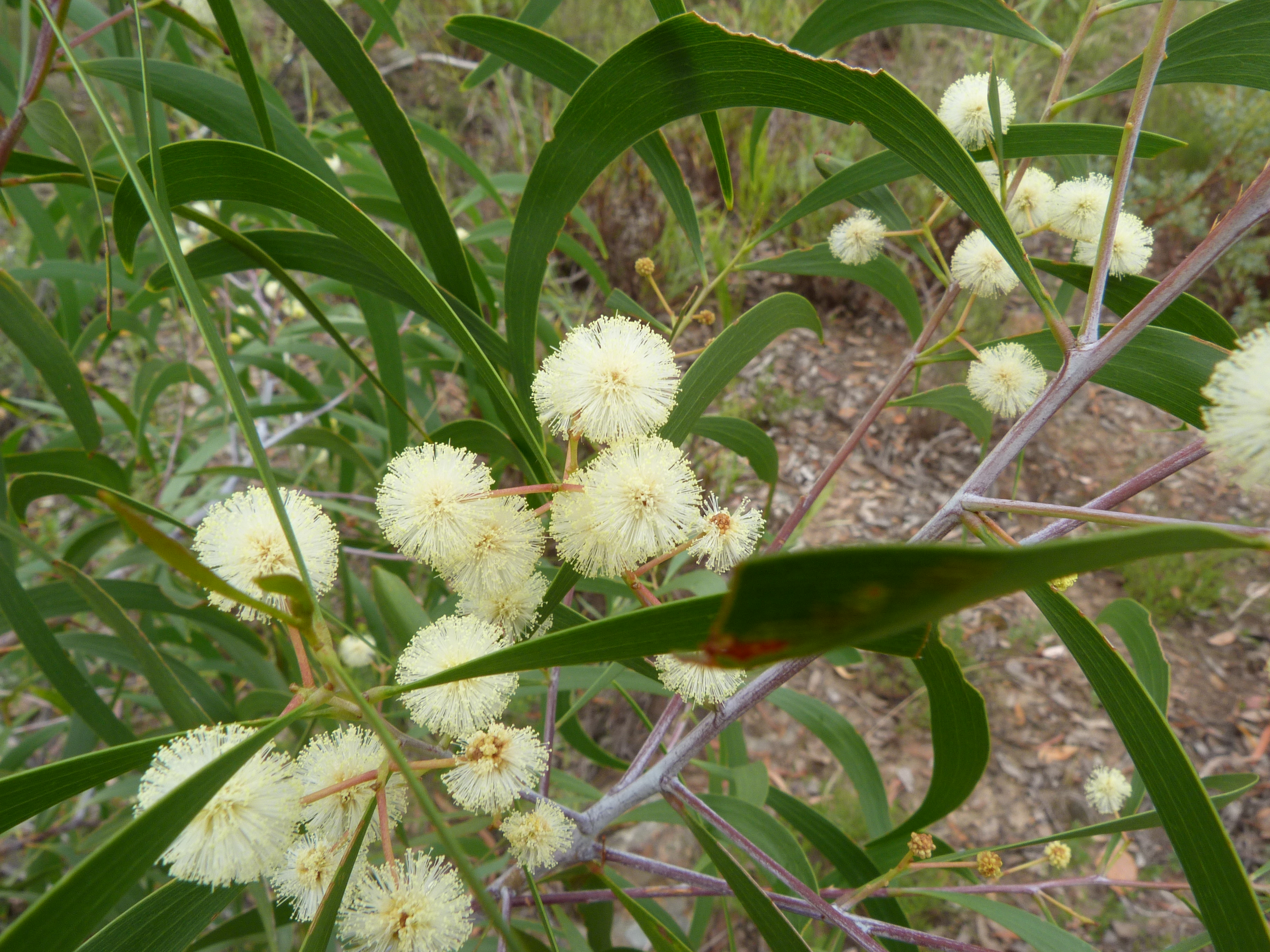
Acacia implexa, commonly known as lightwood or hickory wattle, is a fast-growing Australian tree, the timber of which was used for furniture making. The wood is prized for its finish and strength. The foliage was used to make pulp and dye cloth. The Ngunnawal people of the ACT used the bark to make rope, string, medicine and for fish poison, the timber for tools, and the seeds to make flour.
It is widespread in eastern Australia from central coastal Queensland to southern Victoria, with outlying populations on the Atherton Tableland in northern Queensland and Tasmania's King Island. The tree is commonly found on fertile plains and in hilly country it is usually part of open forest communities and grows in shallow drier sandy and clay soils.
Acacia implexa flowers - photo by Donald Hobern.
Coastal Environment Centre Turns 30 In 2021
Narrabeen's Coastal Environment Centre will reach 30 years of service to the community later this year. The CEC was officially opened on December 13th 1991 by the then Premier Nick Greiner and the then Mayor of Warringah, Councillor Brian Green. The Centre passed to the newly constituted Pittwater Council with the secession from Warringah and grew to become Pittwater’s environmental flagship and a highly regarded regional community environmental education centre with a string of awards to its credit.
In 2012 Pittwater Council’s award-winning Coastal Ambassadors program was extended along the entire NSW coast, thanks to financial support from the NSW Environmental Trust. The Coastal Ambassadors program was started by the Council’s Coastal Environment Centre in 2005. Every year since then, the program has trained volunteers from surf clubs and other community groups to become ‘ambassadors’ for the local marine environment.
Typically, Coastal Ambassadors receive up to 6 weeks training in environmental education on coastal issues, which they then use to teach other volunteers, schoolchildren and visitors about the importance of looking after the coastline.
Since its inception in 2005 the CEC has trained hundreds of Coastal Ambassadors and the program has the backing and support of Surf Life Saving Sydney Northern Beaches, community groups such as Eco Divers and the Surfrider Foundation and the NSW Environmental Trust. One example of the program’s success is that many of Sydney’s northern beaches surf clubs have now undertaken energy audits and measures to improve their club’s sustainability targets.
The CEC also hosts a wide range of initiatives and groups, such as Youth Leading the Way program introduced by OzGreen or hosts local forums, such as those made available by the Friends of Narrabeen Lagoon Catchment (FoNLC).
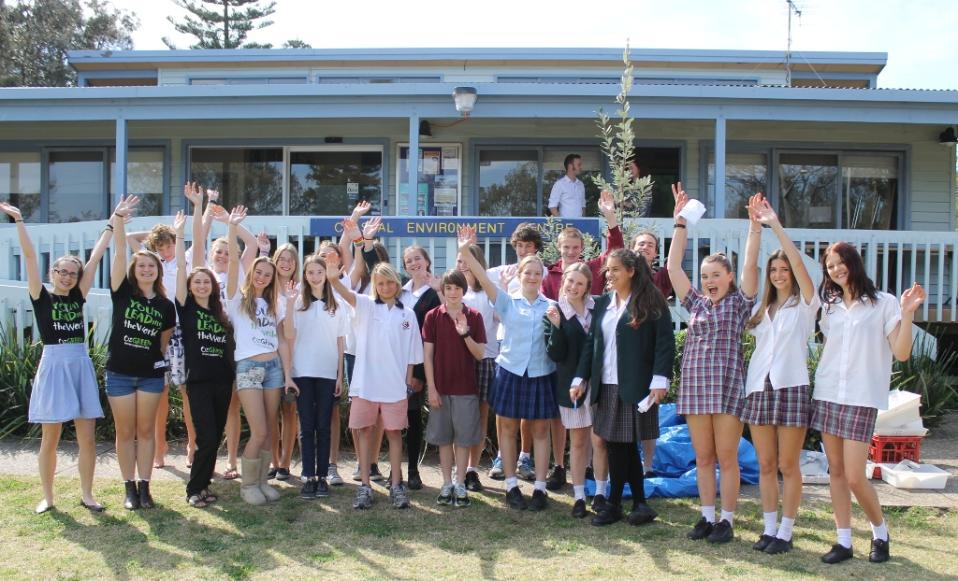
YLTW Program at CEC in 2013 - A J Guesdon photo
Council also presents and offers a wide range of programs and events annually for all ages - the Narrabeen Rockshelf platform walk and talk in the Narrabeen Aquatic Reserve is just one brilliant offering to connect the next generation with their environmental inheritance. Well worth keeping an eye out for, these educational walks and talks are for all ages and interests.
You find out more and keep up to date as we approach that 30th milestone later this year by visiting: environment/coastal-environment-centre
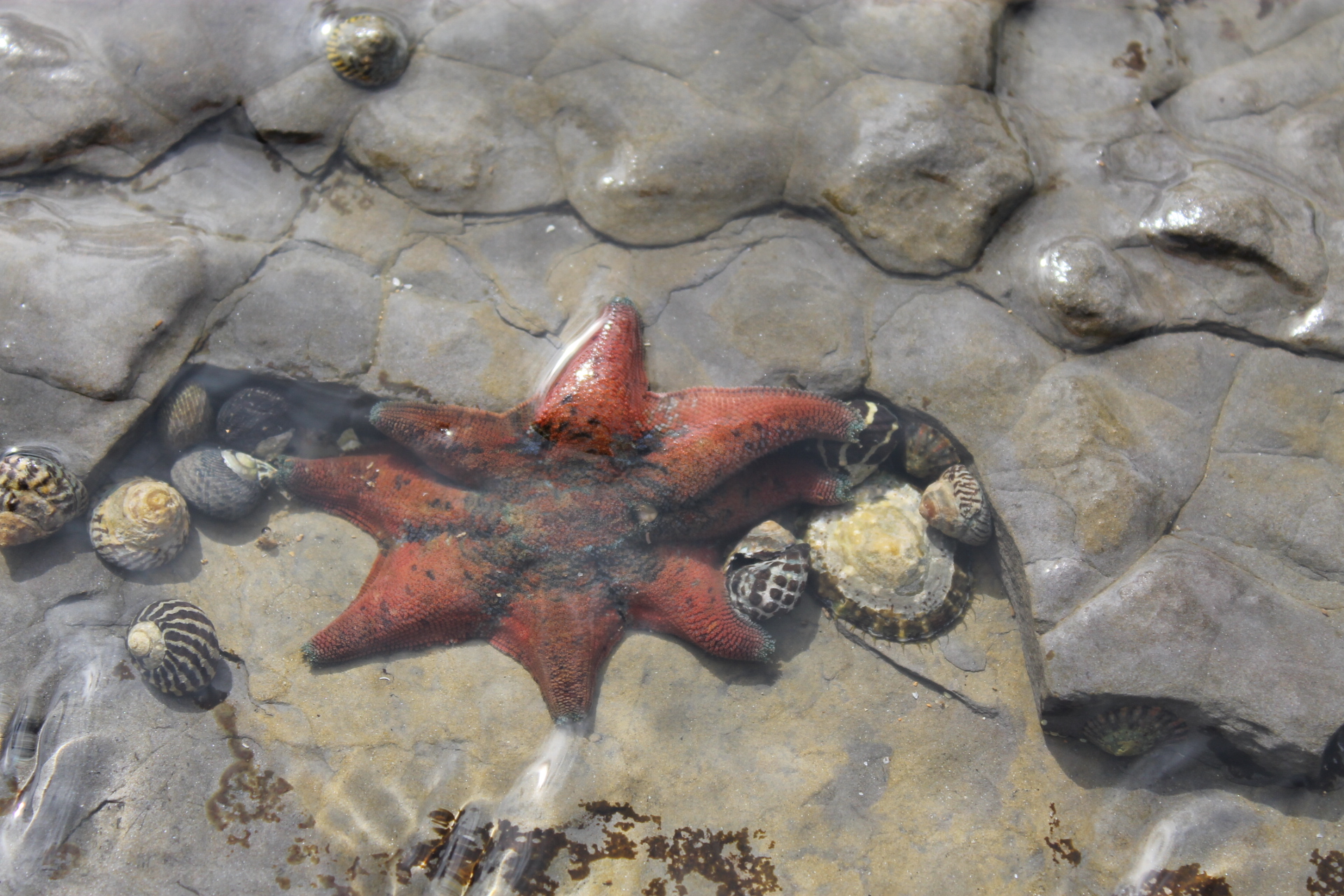
Numb Ray (Hypnos Monopterygius) In Pittwater At Present
Residents report large numbers of Hypnos monopterygius, also known as the coffin ray or Australian numbray, are in the Pittwater estuary at present. This sluggish and nocturnal coffin ray frequents sandy or muddy habitats, where it can bury itself during daytime. It can produce a powerful electric shock reaching 200 volts for attack and defense.
The unusual pear-like shape of the coffin ray distinguishes it from all other rays. Its body is flabby, with two large, kidney-shaped electric organs visible on both sides of the head. The pectoral fins form a greatly enlarged disc about as wide as long, that is thick at the centre and thin at the margins. The leading margin of the disc is straight to gently concave. The eyes are minute and can be elevated on short stalks.
There are also sightings of stingrays (with barbs) being present. The number of stingray incidents in New South Wales is the second highest form of injury caused by marine life in the state, closely behind bluebottle stings, according to figures by NSW Ambulance.
These too are seen in calmer waters. Lacerations on feet and lower legs are the predominant injuries caused by stingrays with barbs, although cases of poisoning from being stung can also occur. There are toxins on those barbs and often pieces of barb can be left behind. Please seek medical advice if you have been stung by a stingray.
Hot water inactivates the toxins "which are usually painful and irritating but rarely cause serious complications". Ice packs can be used for pain relief if hot water is unavailable.
How to treat stingray wounds
- Get yourself out of the water and somewhere safe.
- Place the injured area in hot water, not scalding, for about 20 minutes.
- Control any bleeding.
- If the barb is imbedded, do not remove it.
- Seek medical treatment either with a doctor or emergency department.
Ref: https://aci.health.nsw.gov.au/.../ndec/marine-stings-nmg

Numbray in Sydney - Photo by and courtesy Sylke Rohrlach
Ross River Fever In Pittwater: What You Can Do To Beat Those Mosquitoes
Recent damp and humid weather is bringing out the mozzies, LOTS of mozzies - a reminder that Ross River Fever and Barmah Forest virus are now in our area and there are a few tips you can follow to keep you and your family safe:
1. It is important that if you’re spending a lot of time outdoors in these areas, especially close to wetlands and bush land areas at dawn and dusk when mosquitoes are most active, that you take action to reduce the risk of being bitten. Cover up with long sleeved shirts and long pants and apply an insect repellent. Choose a repellent that contains either DEET (diethlytoluamide), picaridin, or oil of lemon eucalyptus. Apply it to all exposed skin to ensure there is a thin even coat – a dab “here and there” doesn’t provide adequate protection.
2. You can also reduce the incidences of mosquitoes breeding by removing any shallow dishes of water or, if you have these out to feed wildlife and birds, regularly change the water so the stagnant water climate for them to breed is removed. Outbreaks can occur when local conditions of rainfall, tides and temperature promote mosquito breeding, so if we have rain followed by a warm day, check any receptacles in your garden and make sure they are emptied of water.
3. It is also a good idea to ensure you're not being bitten while asleep - repair any flyscreens that are damaged, or install them where absent. There are also a range of plants you can incorporate into your garden that repel mosquitoes and attract mosquito eating insects, such as dragonflies, or birds, possums, frogs and bats that will also reduce their numbers by eating them.
4. Similarly, if you're out and about in our wetland areas not chasing off or disturbing the wildlife that lives there, such as turtles or ducks, with ducklings just a few days old known to eat mosquitoes, will help. They eat them - we need this wildlife.
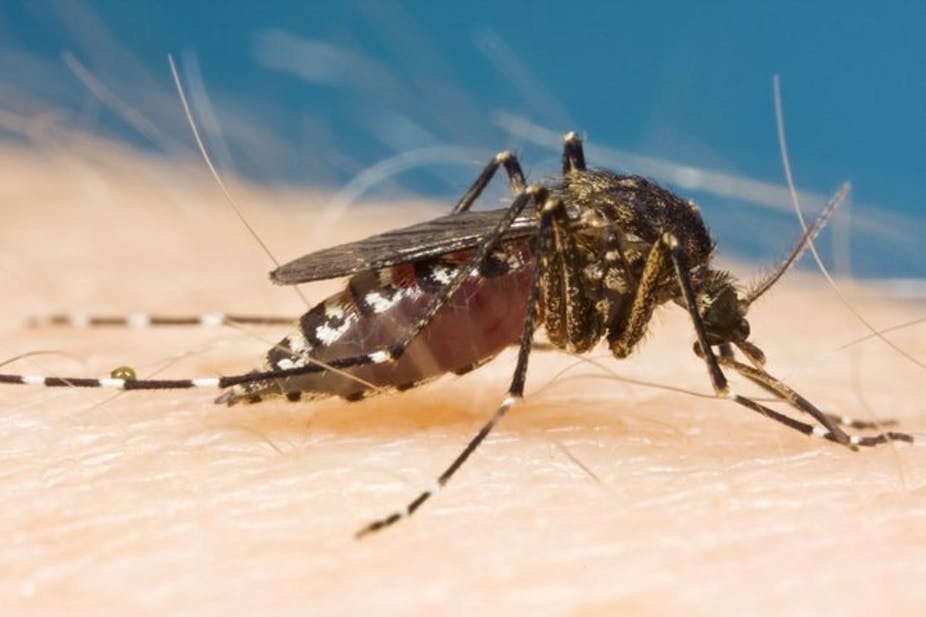
The saltmarsh mosquito, Aedes vigilax, transmits Ross River virus in many coastal regions of Australia. Photo: Mr Stephen Doggett (Medical Entomology, Pathology West - ICPMR Westmead)
Kookaburra Fledgling Feed-Time: 2 New Babies This Year
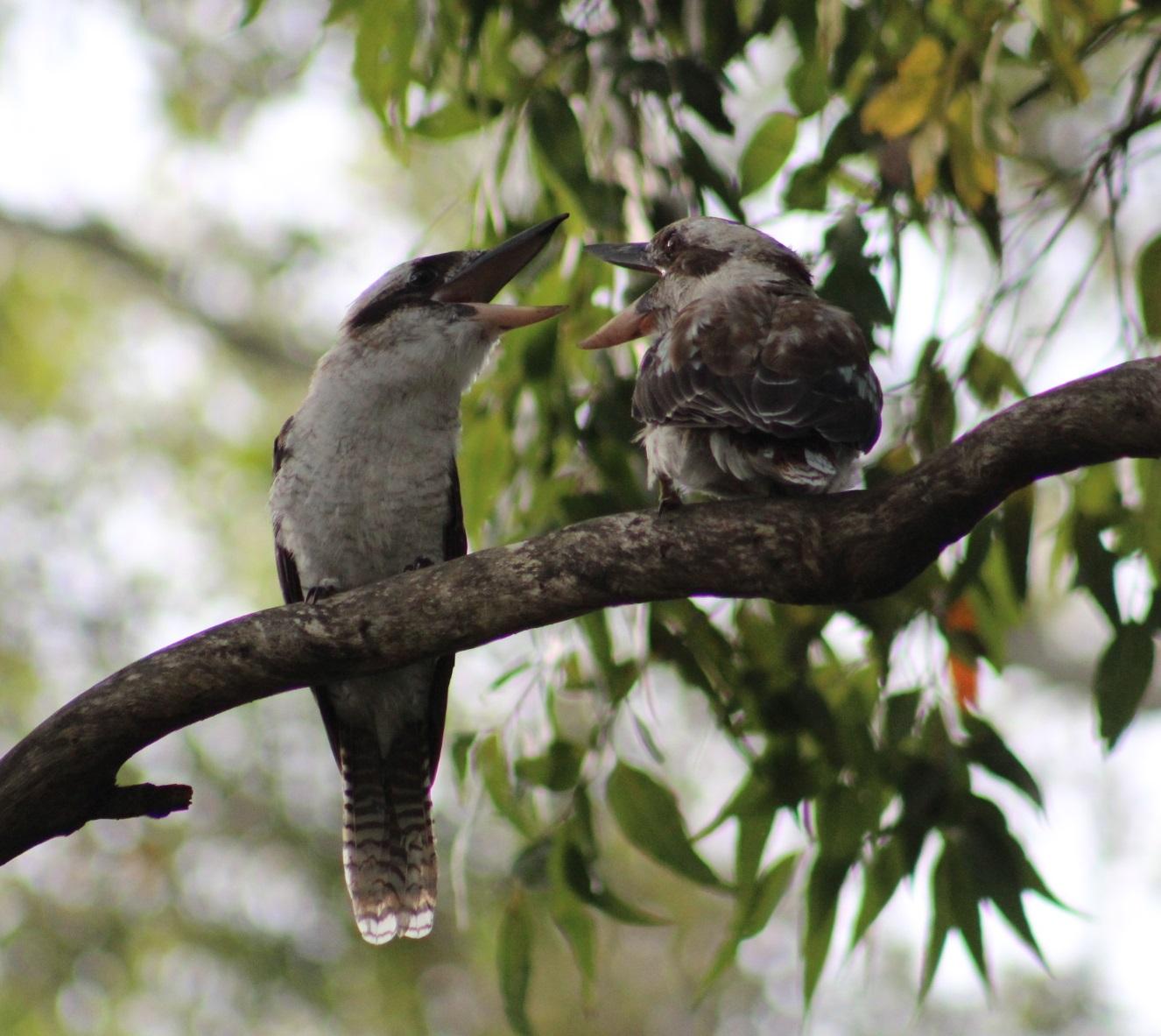
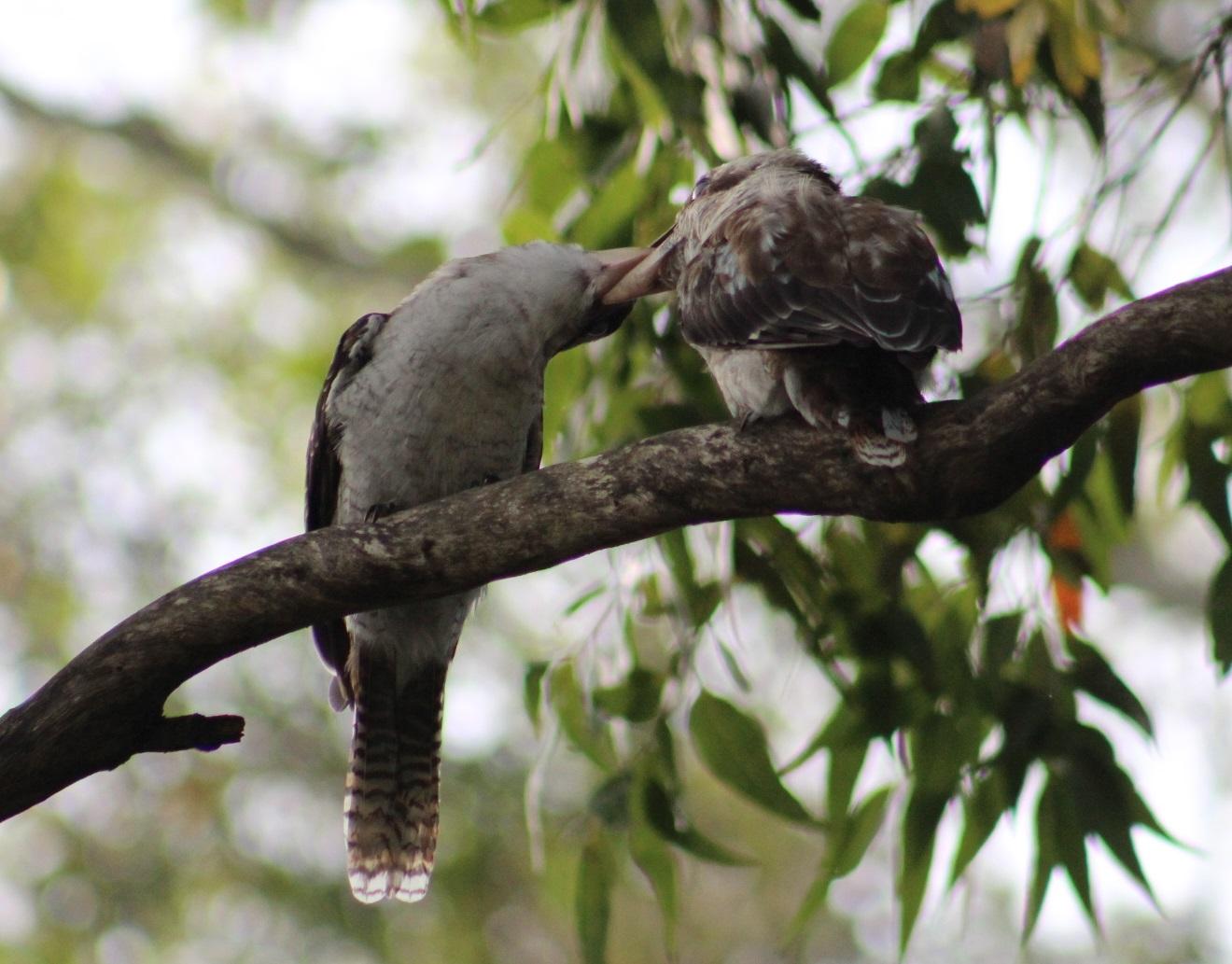
Careel Bay, January 15, 2020. Photos by A J Guesdon.
Upcoming Activities For Friends Of Narrabeen Lagoon Catchment:

Sun 21 February 2021: 7.30 am Walk & Weed along the Narrabeen Lagoon catchment transverse walk.
Start at Oxford Falls walk for 3 1/2 hours, weed for 30min, continue 30min walk and car pool back to start.
Bring gloves and long handled screwdriver if available.
Walk grade: medium.
Bookings essential. Conny 0432 643 295
https://www.narrabeenlagoon.org.au/
Friends of Narrabeen Lagoon Catchment are pleased to announce the next forum will be held on 22 Feb 2021 at 7 pm .
Presenter: Jayden Walsh
Jayden is a keen observer of nature and has some stunning photographs and information to share.
The focus will be on wildlife that lives near the Narrabeen Lagoon and that, if you are fortunate, you may see when on the Narrabeen Lagoon walkway.
For details on how to book for this event are on the website. At: https://www.narrabeenlagoon.org.au/Forums/forums.htm
Narrabeen Beach & Lagoon Clean Up 2021
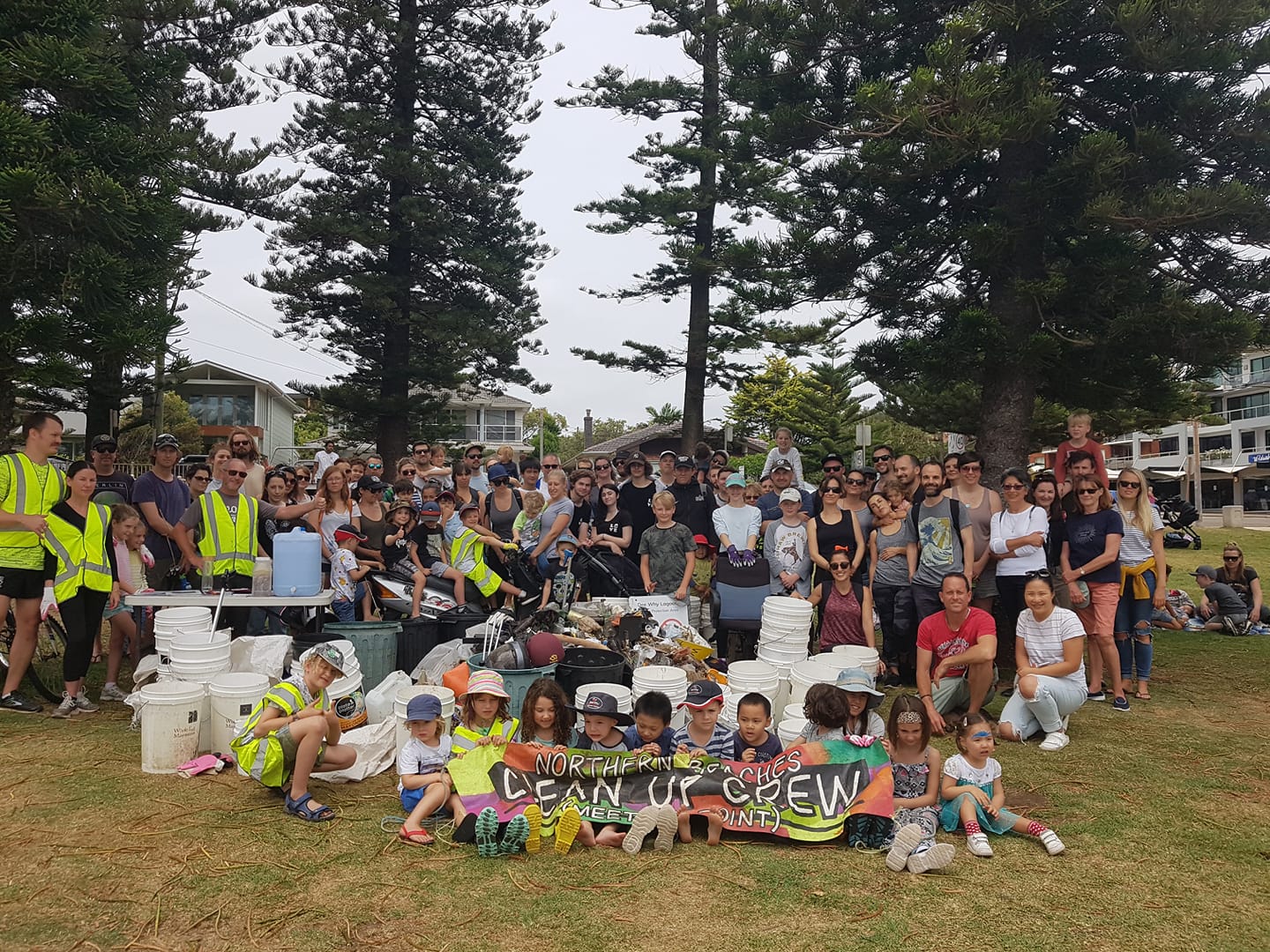
Bushcare In Pittwater
Where we work Which day What time
Avalon
Angophora Reserve 3rd Sunday 8:30 - 11:30am
Avalon Dunes 1st Sunday 8:30 - 11:30am
Avalon Golf Course 2nd Wednesday 3 - 5:30pm
Careel Creek 4th Saturday 8:30 - 11:30am
Toongari Reserve 3rd Saturday 9 - 12noon (8 - 11am in summer)
Bangalley Headland 2nd Sunday 9 to 12noon
Bayview
Winnererremy Bay 4th Sunday 9 to 12noon
Bilgola
North Bilgola Beach 3rd Monday 9 - 12noon
Algona Reserve 1st Saturday 9 - 12noon
Plateau Park 1st Friday 8:30 - 11:30am
Church Point
Browns Bay Reserve 1st Tuesday 9 - 12noon
McCarrs Creek Reserve Contact Bushcare Officer To be confirmed
Clareville
Old Wharf Reserve 3rd Saturday 8 - 11am
Elanora
Kundibah Reserve 4th Sunday 8:30 - 11:30am
 Mona Vale
Mona Vale Mona Vale Beach Basin 1st Saturday 8 - 11am
Mona Vale Dunes 2nd Saturday +3rd Thursday 8:30 - 11:30am
Newport
Bungan Beach 4th Sunday 9 - 12noon
Crescent Reserve 3rd Sunday 9 - 12noon
North Newport Beach 4th Saturday 8:30 - 11:30am
Porter Reserve 2nd Saturday 8 - 11am
North Narrabeen
Irrawong Reserve 2nd Saturday 2 - 5pm
Palm Beach
North Palm Beach Dunes 3rd Saturday 9 - 12noon
Scotland Island
Catherine Park 2nd Sunday 10 - 12:30pm
Elizabeth Park 1st Saturday 9 - 12noon
Pathilda Reserve 3rd Saturday 9 - 12noon
Warriewood
Warriewood Wetlands 1st Sunday 8:30 - 11:30am
Whale Beach
Norma Park 1st Friday 9 - 12noon
Western Foreshores
Coopers Point, Elvina Bay 2nd Sunday 10 - 1pm
Rocky Point, Elvina Bay 1st Monday 9 - 12noon
Gardens And Environment Groups And Organisations In Pittwater
Pittwater Reserves
NSW Government Response To Independent Panel's First Flush Recommendations
December 22, 2020
The NSW Government agrees in principle to all but one of the 10 Independent Panel’s recommendations into the management of the 2020 Northern Murray-Darling Basin first flush event.
Minister for Water, Property and Housing Melinda Pavey said the independent assessment was done to provide key findings to help inform methods of future assessment as well as the future management of flows.
“In February, heavy rain fell over the northern basin and, for the first time in NSW’s history, DPIE – water placed an embargo on floodplain harvesting being ‘actively’ diverted to protect a first flush of water through to the Lower Darling,” Mrs Pavey said.
“The assessment was undertaken to provide clarity as to what we can do better in the same scenario. Many of the proposed actions identified by the panel are closely aligned with, or are already being implemented through, existing projects.
“Several will require further exploration with the community and timeframes will need to be extended accordingly.”
The Panel found the event was managed effectively resulting in good outcomes, but better transparency, including communication would have reduced community concerns.
“The Panel’s recommendations primarily relate to improving transparency and communication – these principles are consistent with several key initiatives already underway,” Mrs Pavey said.
“These include the State Water Strategy, regional water strategies, Aboriginal Water Strategy, review of north-west flow targets, remake of the Barwon-Darling Water Sharing Plan, and the Western Weirs project.”
The full NSW Government response is available on the department's website: Northern Basin First Flush Assessment.
Amended Barwon-Darling Water Sharing Plan Improving Connectivity
January 12, 2021
Under the Water Sharing Plan for the Barwon-Darling, the Resumption of Flows Rule will be activated on 12 January 2021 for the first time.
Minister for Water, Property and Housing Melinda Pavey said this milestone is a great example of NSW leading the way in achieving a proper balance between social, economic, environmental and cultural water management.
“The NSW Government is implementing some of the most significant reforms in a generation to improve water management across the State,” Mrs Pavey said.
“Active management protects environmental water in the river system by changing how flows are managed, and when licence holders can and cannot access water from the river. This will reduce the need for temporary water restrictions to protect environmental flows.
The Resumption of Flows Rule was incorporated into the Barwon-Darling Unregulated Water Sharing Plan in July 2020, and requires holders of A, B and C class licences not to pump when flows resume along the river after a prolonged dry period.
“We need these new environmental water rules because the old access rules for licence holders did not differentiate between flows from rainfall and releases that benefit the environment,” Mrs Pavey said.
The first flow of water after a dry period can trigger significant social, cultural and environmental outcomes. These flows maintain and connect vital refuge pools for fish and other water dependent biota, improve water quality, and replenish town water supplies.
Prior to the new rules, licence holders could pump when the commence-to-pump threshold was reached, even if part of the flow was released to benefit the environment. This meant held environmental water could be extracted, and may not have benefitted the environment the way it is intended to.
In some cases its removal from the system prevented flows from passing downstream to replenish the lower reaches of the river and towns such as Wilcannia.
“Including these reforms in the NSW Water Sharing Plans ensures they are enduring and certain,” Mrs Pavey said.
The resumption of flow rule will be triggered due to the flow at Wilcannia being below 200ML/day for 90 days.
Pumping can resume in line with existing access announcements once there is a forecast for river flow at Wilcannia of 400 ML/day for a minimum of 10 days, or a forecast of a cumulative flow to pass Bourke of 30,000 megalitres.
Information confirming the status of the Resumption of Flows Rule will be available on the WaterNSW water insights portal.
Visit the resumption of flow rule (PDF 340.1 KB) in the Barwon-Darling water sharing plan for more information.
Photos from the field: zooming in on Australia's hidden world of exquisite mites, snails and beetles

Environmental scientists see flora, fauna and phenomena the rest of us rarely do. In this series, we’ve invited them to share their unique photos from the field.
Which animals are quintessentially Australian? Koalas and kangaroos, emus, tiger snakes and green tree frogs, echidnas and eastern rosellas, perhaps. And let’s not forget common wombats.
Inevitably, most lists will be biased to the more conspicuous mammals and birds, hold fewer reptiles and frogs, and likely lack invertebrates — animals without a backbone or bony skeleton — altogether.
I’m an invertophile, fascinated by our rich terrestrial invertebrate fauna, so my list will be different. I’m enchanted by stunning dragon springtails, by cryptic little Tasmanitachoides beetles, and by the poorly known allothyrid mites, among thousands of others.
Australia’s terrestrial invertebrate multitude contains several hundred thousand uniquely Australian organisms. Most remain poorly known.
To preserve our biodiversity, we first must ask: “which species live where?”. For our invertebrates, we are a long way from knowing even this.
The Black Summer Toll
Last year, a team of scientists estimated that the Australian 2019-2020 bushfires killed, injured or displaced three billion animals. That was a lot. But it was also a woefully inadequate estimate, because it only accounted for mammals, reptiles, birds and frogs.
Hidden from view, many trillions more invertebrates burned or were displaced by the fires. And yes, invertebrates are animals too.

Admittedly, it’s hard to come to terms with invertebrates because they’re often hard to find and difficult to identify. Most species are inconspicuous, even if they belong to incredibly abundant groups, such as mites and springtails, which can occur in numbers exceeding 10,000 per square metre.
Most invertebrates are poorly known because there are so many species and so few people working on them. In fact, it’s likely only a quarter to one-third of Australia’s terrestrial invertebrate fauna is formally described (have a recognised scientific name).
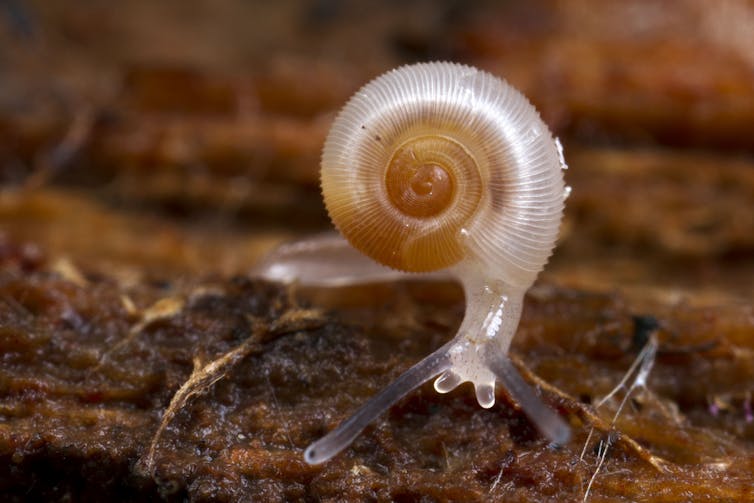
One of the problems invertebrates have, in terms of attracting attention, is that many are not easily seen with the naked eye.
Macrophotography can magnify these wonders for a view into a world most of us are completely unfamiliar with. Even then, it often will be hard to know what we see. Everyone will recognise a kangaroo, but who can identify an allothyrid mite?
The photo below shows an undescribed species of mite from the family Allothyridae, from Mount Donna Buang in Victoria. The mite family Allothyridae has three described Australian species, and dozens more awaiting description.
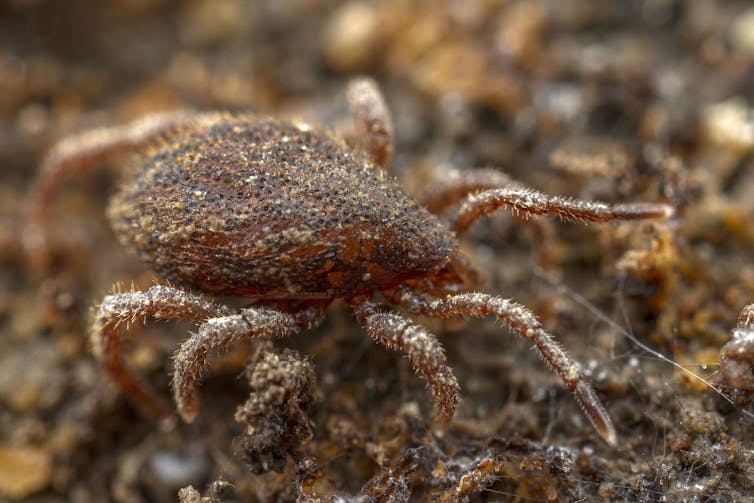
This collage shows a selection of mites found in the forests of southeastern Australia. It’s likely many of the species shown here are unknown to science.

A Deeply Ancient Lineage
Animal ecologists, most of whom work on vertebrates, often joke that I “study the ‘food’, haha…”. They think they’re funny, but this reflects a deep seated bias — one extending from scientists to the wider public. This limits the development of a comprehensive understanding of biodiversity that has flow-on effects for conservation more broadly.
It’s true: invertebrates are food for larger animals. But their vital role in maintaining Australia’s ecosystems doesn’t end there.
Every species has an evolutionary history, a particular habitat, a set of behaviours reflecting that history, and a role to play in the ecosystem. And many terrestrial invertebrates belong to especially ancient lineages that record the deep history of Australia’s past.
The moss bug family Peloridiidae, for example, dates back more than 150 million years. For context, the kangaroo family (Macropodidae) is likely 15-25 million years old.
Their history is reflected in the breakup of the ancient supercontinent, Gondwana. In fact, Australian species of moss bugs are more closely related to South American species than to those from nearby New Zealand.
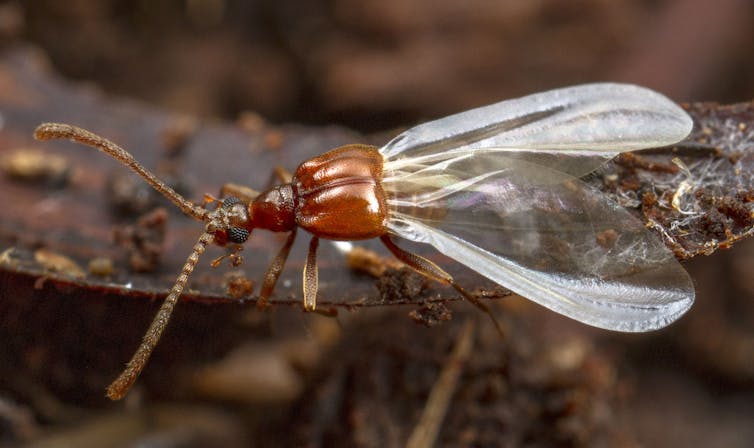
This is a common pattern in terrestrial invertebrate groups. It reflects how the New Zealand plate separated from the remainder of Gondwana about 80 million years ago, while the Australian plate remained connected to South America via Antarctica.
Similar stories can be told from across the invertebrate spectrum. The photo below shows a few examples of these relics from Gondwana.
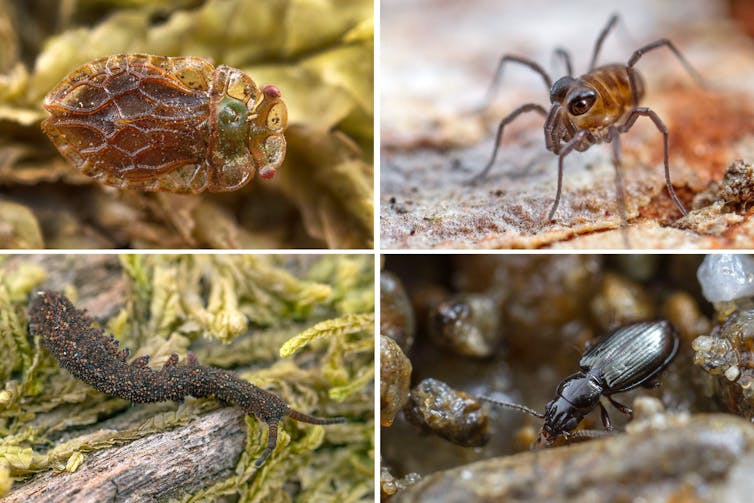
Their Fascinating Evolution
Overprinting this deep history are the changes that occurred in Australia, especially the drying of the continent since the middle Miocene, about 12-16 million years ago.
This continent-wide drying fragmented wet forests that covered much of the continent, resulting in the restriction of many invertebrate groups to pockets of wetter habitat, especially along the Great Dividing Range and in southwestern Australia.
Read more: Trapdoor spider species that stay local put themselves at risk
A consequence of this was the evolution in isolation of many “short-range endemic” species.
A short-range endemic species means their geographic distribution is less than 10,000 square kilometres. A short-range endemic mammal you might be familiar with is Leadbeater’s possum, restricted to the wet forests of the Victorian Central Highlands.
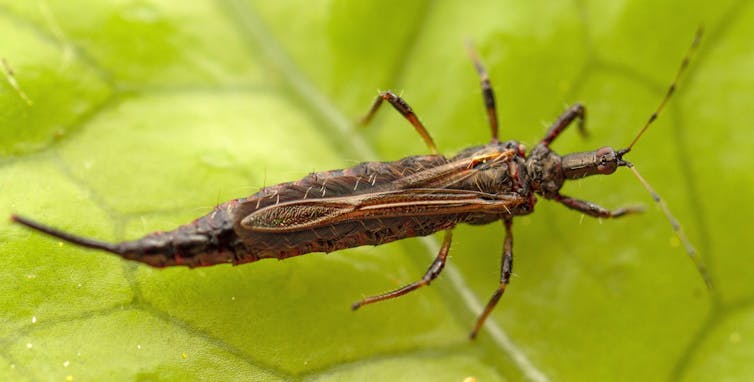
But short-range endemism is much more common in invertebrates than other organisms. This is because many invertebrates are poor dispersers: they don’t move between habitat patches easily. They may also maintain viable populations in small areas of suitable habitat, and are frequently adapted to very specific habitats.
Take Tropidotrechus, pictured below, a genus of beetles mostly restricted to the same region as Leadbeater’s possum. They, however, divide the landscape at a much finer scale because they’re restricted to deep leaf litter in cool, wet, forest gullies.
As Australia dried, populations of Tropidotrechus became isolated in small patches of upland habitat, evolving into at least seven species across the ranges to the east of Melbourne.
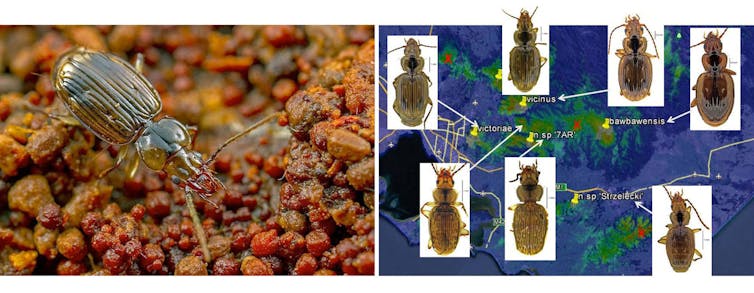
Discoveries Waiting To Happen
The trouble with knowing so little about Australia’s extraordinary number of tiny, often locally unique invertebrates, is that we then massively underestimate how many of them are under threat, or have been badly hit by events like the 2019-2020 fires.
If we wish to conserve biodiversity widely, rather than only the larger charismatic wildlife, then enhancing our knowledge of our short-range species should be a high priority.
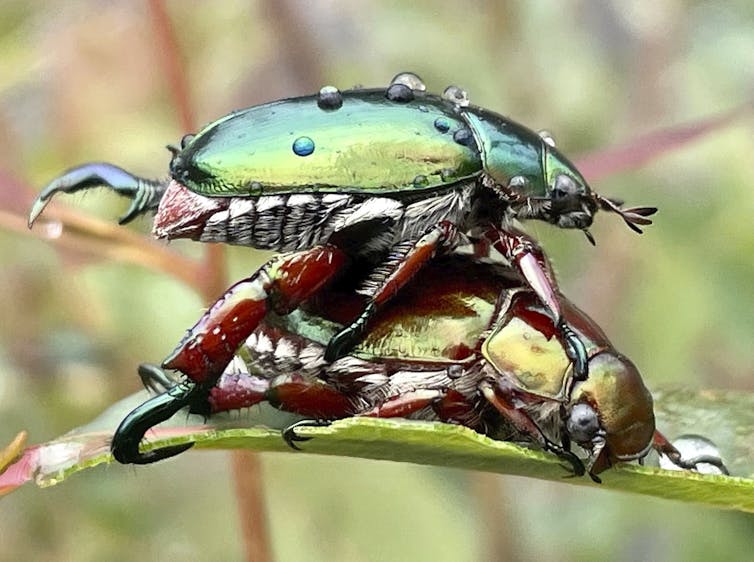
We’ve only just scratched the surface of Australia’s wonderful invertebrate fauna, so there are enough discoveries for everyone.
You can join iNaturalist, a citizen science initiative that lets you upload images and identify your discoveries. Perhaps you’ll discover something new — and a scientist just might name it after you.
Read more: Want to teach kids about nature? Insects can help ![]()
Nick Porch, Senior Lecturer in Environmental Earth Science, Deakin University
This article is republished from The Conversation under a Creative Commons license. Read the original article.
75% of Australia's marine protected areas are given only 'partial' protection. Here's why that's a problem
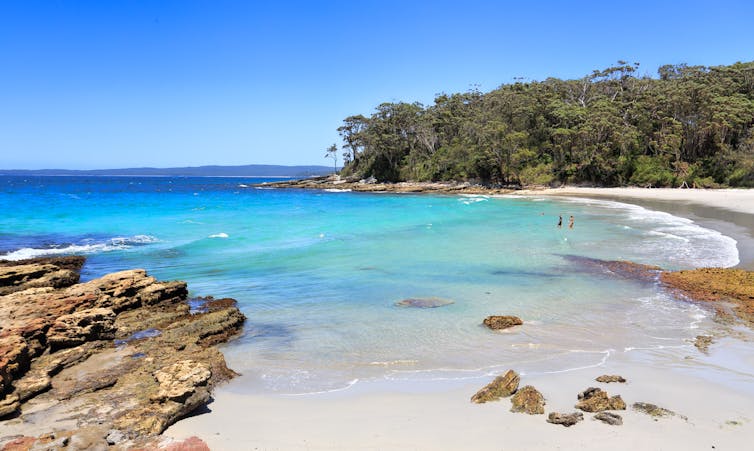
A global coalition of more than 50 countries have this week pledged to protect over 30% of the planet’s lands and seas by the end of this decade. Their reasoning is clear: we need greater protection for nature, to prevent further extinctions and protect the life-sustaining ecosystems crucial to human survival.
The globally recognised tool to safeguard marine biodiversity is to designate a “marine protected area”. But not all protected areas are created equal.
The level of protection these areas provide depends on the activities permitted in their boundaries. For example, in “fully” protected areas, no plants or animals can be removed or harmed. Meanwhile, “partially” protected areas allow various extractive activities to occur, such as fishing and sometimes even mining.
Australia prides itself on having one of the largest marine protected area networks in the world, which includes iconic locations such as the Great Barrier Reef, Jervis Bay in New South Wales, Wilson’s Promontory in Victoria and Rottnest Island in Western Australia. But only one quarter of this network is fully protected.
The remaining three quarters are only partially protected, with vast areas allowing fishing, aquaculture and mining exploration. This is despite industrial-scale extraction of resources going against international guidelines for protected areas.
So why is this a problem? Our two recent research papers show partially protected areas don’t contribute much to wildlife conservation, yet take valuable conservation resources away from fully protected areas, which need them more.
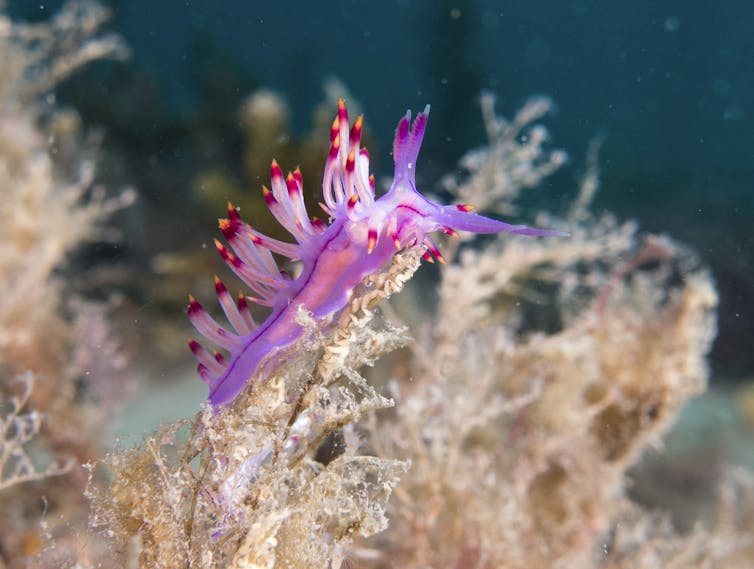
The Gap Between Fully And Partially Protected Areas
Our landmark study, published today, looked at marine protected areas in southern Australia. We gathered social and ecological data, including conducting 439 interviews, across five states and 7,000 kilometres of coastline.
We found partially protected areas had no more fish, invertebrates or algae than unprotected areas. Fully protected areas, by comparison, had 30% more fish species and over twice the total weight of fish compared to unprotected areas.
Read more: Why marine protected areas are often not where they should be
We also found partially protected areas were no more of an attraction to locals and visitors than unprotected areas — they had similar numbers and mix of users, such as walkers, swimmers, fishers and divers.
On the other hand, fully protected areas were attractive to locals and visitors for their abundant wildlife and level of protection. They had twice as many divers and more than three times as many snorkelers compared to unprotected areas.
What’s more, swimmers, divers and snorkelers said they experience significantly more marine life in fully protected areas, but not partially protected areas.
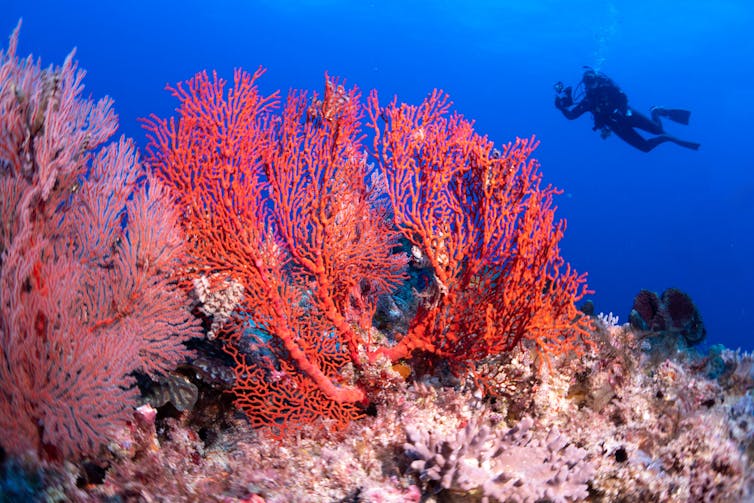
Defying Public Expectations
The Australian marine protected area network has been moving further away from public expectations. In a 2020 social study, researchers found Australians are generally confused about what activities are permitted in these areas.
Survey respondents were presented with the full list of activities allowed within partially protected areas, and asked to indicate which activities they understood to be permitted or prohibited within marine protected areas in Australia.
Overwhelmingly, they believed marine protected areas offer strict protection to the marine environment, preventing all types of extractive uses, including recreational fishing.
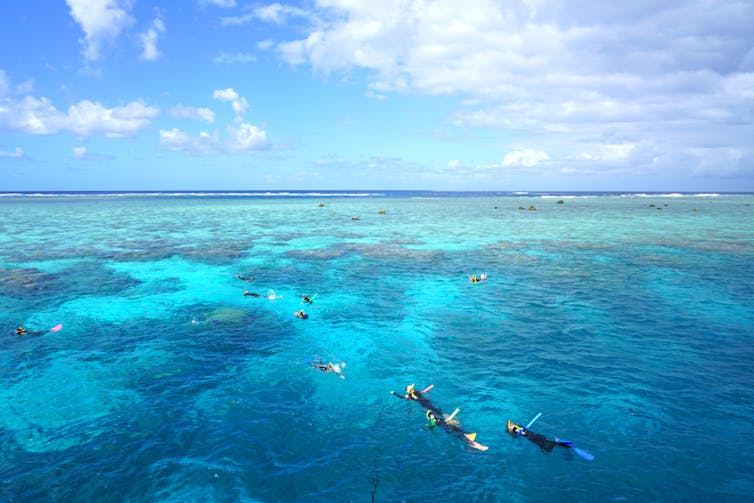
The majority of Australia’s marine protected area network allow for commercial fishing, but few respondents were aware of this. Fewer still were aware large areas permit destructive activities, such as bottom trawling, which can destroy the seabed. The research team also documented many cases where protection has been downgraded, such as the Solitary Islands and Jervis Bay Marine Parks in NSW.
It’s clear Australians expect the marine protected area network to adequately safeguard our unique wildlife. Yet these findings show their views are in stark contrast to the reality of marine environmental protection.
A Matter Of Money
There are costs associated with partially protected areas - they consume conservation resources and occupy space that could otherwise be allocated to more effective protection. In fact, research from 2011 found areas with a mixture of partial and full protection are up to twice as expensive to manage than a simpler fully protected area.
Partially protected areas do have a role in our overall marine network, but they should be used for specific purposes such as enabling traditional management practices, protecting important breeding sites, or acting as buffer zones around fully protected areas.
Read more: Changes to Australia's marine reserves leave our oceans unprotected
The recent changes to Australia’s marine reserve network represent an extremely worrying trend, as fully protected areas such as in the Coral Sea and Batemans Bay have been opened up to fishing.
Given the uncertainty surrounding the effectiveness of partially protected areas globally, at a time when we face increasing challenges from climate change and loss of biodiversity, the findings of our two recent Australian studies indicate we should be aiming for more fully protected areas, not less.
If the world is to protect 30% of all lands and seas by the end of this decade, those protected areas need to be monitored closely to ensure they are delivering on their goals and expectations.
Read more: Worried about Earth's future? Well, the outlook is worse than even scientists can grasp ![]()
John Turnbull, Postdoctoral research associate, UNSW; Carly Cook, Lecturer Head, Cook Research Group; School of Biological Sciences , Monash University; Emma Johnston, Professor and Dean of Science, UNSW; Graeme Clark, Senior Research Associate in Ecology, UNSW, and Kelsey Roberts, Post doctoral researcher at the School of Marine and Atmospheric Sciences, Stony Brook University (The State University of New York)
This article is republished from The Conversation under a Creative Commons license. Read the original article.
Birds that play with others have the biggest brains - and the same may go for humans
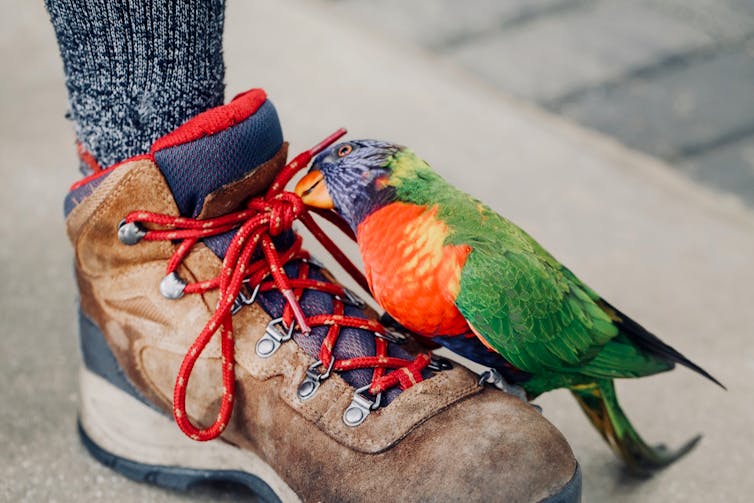
Have you ever seen magpies play-fighting with one another, or rolling around in high spirits? Or an apostlebird running at full speed with a stick in its beak, chased by a troop of other apostlebirds? Well, such play behaviour may be associated with a larger brain and a longer life.
For the past 50 years, international animal cognition research has often related the use of tools such as rocks and sticks to cognitive abilities in animals. But my research on Australian native birds, published in Scientific Reports, casts doubt on long-held assumptions about the links between large brains and tool use.
My study found no significant association between tool use and brain mass. However, very clear differences in relative brain mass emerged when birds showing play behaviour were compared to those that didn’t play. In particular, birds that played with others (known as social play) had the largest brain mass, relative to body size, and even the longest lifespans.
The results suggest play behaviour may be an important driver in the evolution of large brains in a number of species, including humans.
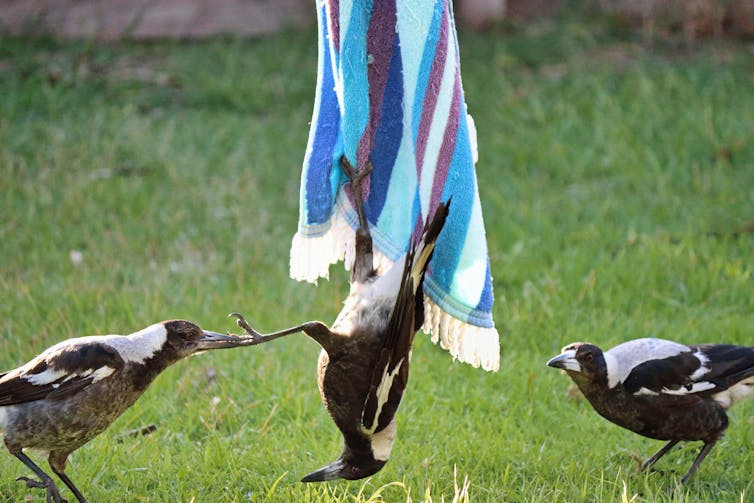
Tool Use In Birds
Tool use has been studied in a wider range of species than play behaviour. Some internationally famous Australian examples include:
the black-breasted buzzard releasing rocks from their beaks to crack emu eggs
the black kite picking up burning embers and twigs and dropping them on dry grass areas to start a fire. The bird then feasts on fleeing or injured insects and vertebrates
palm cockatoos that drum with a stick.
According to a classic theory known as the “technical intelligence hypothesis”, humans and other animals developed large brains because circumstances forced them into ever more sophisticated tool use.
Read more: Bird-brained and brilliant: Australia's avians are smarter than you think
So What Is Bird Play?
Play behaviour usually occurs in juveniles but in some species, such as little corellas or galahs, it extends into adulthood. Play behaviour occurs in species which tend to have long juvenile periods, long-term support from parents and which grow up in stable social groups.
Play behaviour is usually subdivided into three categories: solo play, object play and social play.
Solo play: this may involve a single bird running, skipping, jumping, ducking, rolling, hanging, swinging, dancing, sliding and snow-romping. Solo play is the most widespread form of play, common among honeyeaters, parrots, magpies, currawongs, butcherbirds, riflebirds and some pigeon species.
The best acrobat among the pigeons is probably the topknot pigeon, but rainbow lorikeets are also known to love swinging.
Object play: this involves objects of any kind, including sticks, stones and small household items. Object players might carry a stick or stone or even just a leaf around, drop it, then pick it up again and run with it.
Object players are not as numerous as solo players but still widespread across species. Click here to read a lovely description of a kookaburra absorbed in playing with a stone.
Social play: involves two or more individuals. Social play is so far the rarest category. It might involve one bird holding an object in its beak and the others chasing it. Published cases are largely limited to parrots and corvids, and are known in magpies and ravens.
Read more: What Australian birds can teach us about choosing a partner and making it last
White-winged choughs are known to play a game in which two youngsters simultaneously grab a small stick or a bunch of grass, then each tries to wrest it from the other.
It’s important to note that social players are also solo and object players, but solo or object players may not be social players. The latter is considered a more complex form of play.
It turns out these categories are meaningful when used to analyse a potential link to brain mass. Information on brain weight/mass in Australian birds has been available only since an important study in 2014. It identified brain volumes and body sizes of all Australian bird species, enabling researchers to link these biological data to behavioural data.
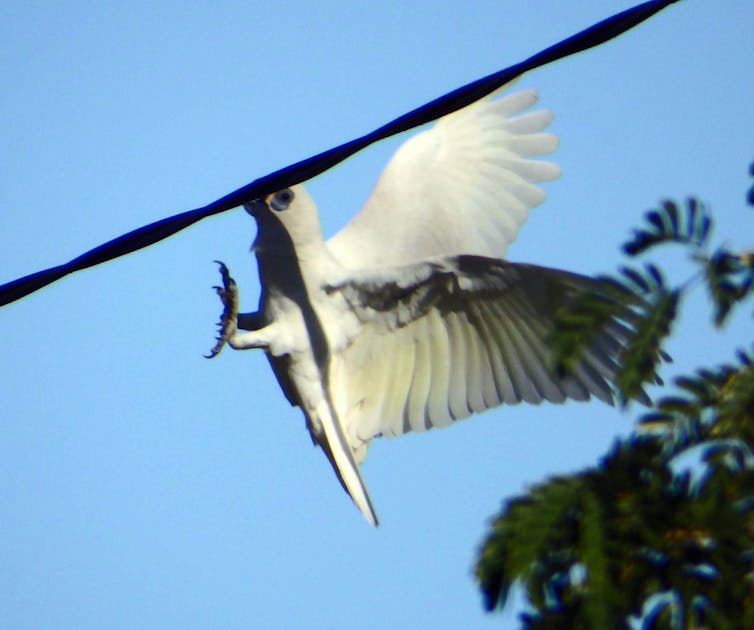
A Surprising Link
My study involved 77 native Australian bird species for which full data sets were available. The results were more than surprising. In the samples used, tool use seems to confer no advantage whatsoever in terms of brain size or life expectancy: no matter whether a species showed tool using or not, relative brain masses were not different. However the results showed, rather dramatically, that brain size and forms of play are associated.
Social players, versus other players and versus non-players showed significantly different average brain sizes in each category:
non players have the lowest average brain size
solo players had slightly larger brains than non-players
object players had larger brains again
social players had by far the largest average brain size relative to body weight.
These results are by no means confined to parrots, but are found in songbirds and other orders. Whether this holds for birds globally is not yet known. However, since parrots and songbirds first evolved in Australia, then spread to the rest of the world, the results may indeed hold for birds outside Australia. More research will be needed.
Read more: Magpies can form friendships with people – here's how
Which came first – play resulting in large brains or large brains triggering play behaviour – is not known. But whichever way one looks at it, playing socially or even just playing at all, is related to a bigger brain and a long life.
So what does all this mean for human brain evolution? It may be a long shot, but the stages of development in humans and birds seem to have some similarities and this may be significant.
Offspring in humans, as in great apes and other primates, also develop slowly, have protracted childhoods and play extensively as do a surprising number of Australian native birds. It may mean playing together offers more than just passing the time. It could be an evolutionary driver for intelligence, and even for a long life.![]()
Gisela Kaplan, Emeritus Professor in Animal Behaviour, University of New England
This article is republished from The Conversation under a Creative Commons license. Read the original article.
How Australia can phase out coal power while maintaining energy security
Daniel D'Hotman, University of Oxford and Steven Hamilton, Crawford School of Public Policy, Australian National UniversityThe end of coal-fired generation in Australia is inevitable.
Zero marginal cost, zero emissions energy is now a reality. Wind and solar are cheaper sources of new electricity than coal in most cases, putting significant pressure on the profitability of the inflexible, ageing coal generators.
The only questions are when coal-fired power stations will close and how well Australia will manage that phasedown.
That’s why we need to talk about the role governments can play to ensure the transition is orderly, maintains energy security, avoids price spikes that have followed past closures, looks after affected workers and communities, and ensures Australia meets its commitment to reduce greenhouse gas emissions by 2030 to 26-28% below 2005 levels.
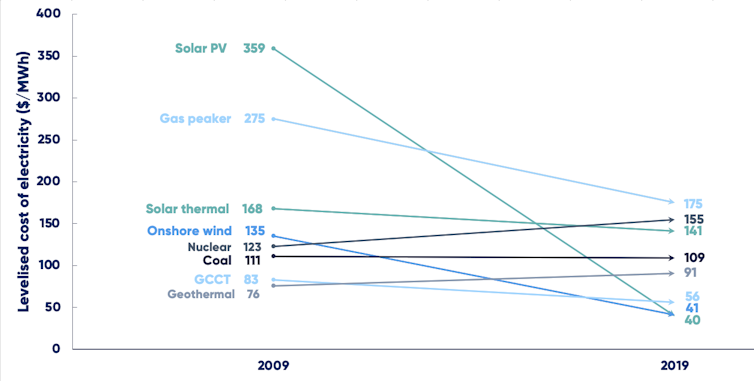
At least halving emissions from coal-fired power stations (which account for about 90% of electricity sector emissions) by 2030 is an obvious route to achieve Australia’s international commitments.
Given most state governments are already committed to forcing renewables into the grid at record pace, that could happen even without federal action.
But continuing down the current path will be unnecessarily costly, and pose significant risks to supply and prices as coal-fired generators exit on sporadic timelines based on their viability. These risks are part of the reason why Australia’s Energy Security Board is considering mechanisms that facilitate an orderly transition from coal-fired generation to renewables as one of four priority reform areas.
Read more: 'Unjustifiable': new report shows how the nation's gas expansion puts Australians in harm’s way
National leadership and careful policy design are needed to enable coal plant operators to bow out of the market gracefully, and in a manner that secures certainty for investors, consumers, workers and communities.
Learning From Past Closures
Past closures of South Australia’s Northern and Playford B power stations in Port Augusta (in 2016) and Victoria’s Hazelwood power station in the Latrobe Valley (in 2017) illustrate this point.
Price spikes followed the closure of these plants. In the case of Hazelwood, majority owner Engie gave barely five months’ notice of its closure in March 2017. With Hazelwood, a brown-coal-fired generator accounting for 20% of Victoria’s electricity supply and 5% of national output, the supply ramifications were significant. Victoria’s average electricity prices increased from A$60 to A$100 per megawatt hour (MWh).
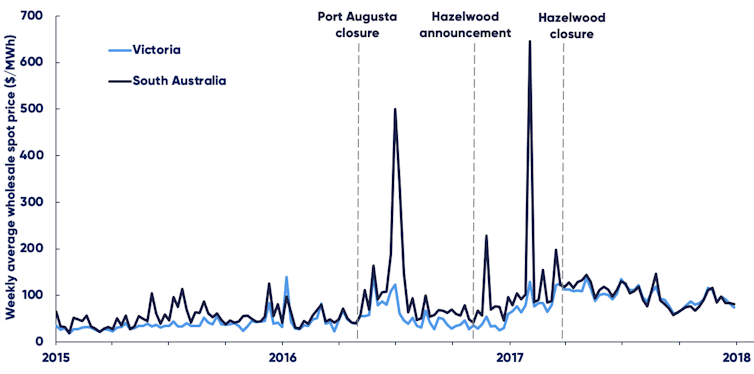
These offer a stark warning to policy makers. The market requires adequate notice of coal-fired generator exits. Greater certainty provides investors with the assurance they need to build enough capacity to replace retiring coal plants, and the infrastructure to connect them to the grid. A haphazard transformation is in no one’s interests.
A New Coal-Generation Phasedown Mechanism
We outline a market-based mechanism to achieve just that in a report published by the Blueprint Institute, an Australian think tank established last year to promote rational, pragmatic policy proposals.
The Coalition has generally claimed to oppose market-based mechanisms — such as emissions trading schemes or carbon taxes — to reduce greenhouse gas emissions. But the Abbott government in 2014 introduced an emissions trading scheme alongside its A$2.5 billion Emissions Reduction Fund, a mechanism the Morrison government rebadged in 2019 as the Climate Solutions Fund. A “Safeguard Mechanism” sets emissions caps for the country’s highest-emitting businesses, with emissions permits tradeable on the open market.
Read more: Australia's new cap on emissions is a trading scheme in all but name
To facilitate the orderly phasedown of coal-fired electricity generation, we propose a “Coal-Generation Phasedown Mechanism” (CPM), leveraging the Safeguard Mechanism to establish sector emissions targets — for 2026, 2028 and beyond 2030.
A key component of the CPM is the use of auctions to achieve withdrawals of coal generation from the electricity market. Auctions are commonplace in commercial and government contexts. The federal government has long used auctions to allocate telecommunications spectrum, for example, and the Emissions Reduction Fund uses reverse auctions to buy the most cost-effective emissions abatement.
The CPM would set emissions targets to phase down coal-fired generation to halve current emissions by 2030. Under a well-designed auction system, the least profitable coal generators would withdraw from the market first, ensuring emissions reductions occur at minimum cost.
One possible scenario is shown in the graph below. Example generators have been chosen based on their operating costs and approximate remaining life. Those with higher costs and a shorter remaining life have greater incentives to bid for earlier exits.
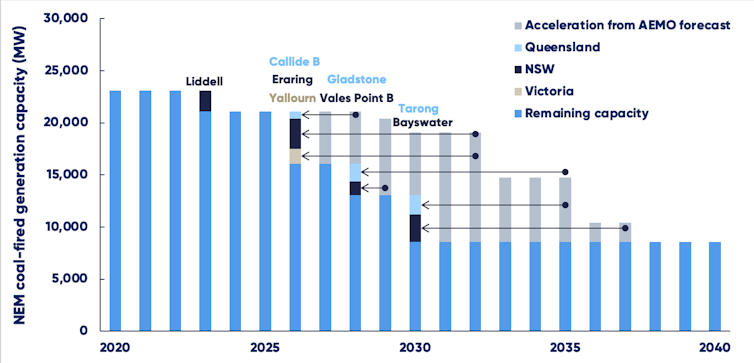
The CPM should also be designed to ensure financial support for affected workers. This could be in the form of redeployment, retraining opportunities or generous remuneration in the case of retrenchment.
Who Should Pay?
A phasedown of coal-fired generation will come at a cost to someone — either taxpayers or investors in coal-fired generation. This cost can be made larger or smaller. It can be hidden from view. But it cannot be avoided. The proper role for government is to minimise and fairly distribute those costs.
We can’t predict exactly how much the phasedown will cost, because that depends on information known only to the generators. But a market-based mechanism is sure to minimise those costs.
The CPM can be designed to ensure the least viable plants close first. How much money generators receive to close or pay to stay open is an entirely separate question. The CPM can be designed to accommodate any financial commitment by taxpayers.
At one extreme, the federal government could pay generators to close by fully compensating auction participants for the loss of future profits, as has been adopted in Germany. But this would likely require a federal funding commitment significantly larger than under the existing Emissions Reduction Fund, which might make it politically unpalatable.
At the other extreme, the government could charge operators for the right to stay open. One significant advantage of this option is it would raise revenue that could then be used to support directly affected communities. This could be modelled on Western Australia’s “Royalties for Regions” program, which allocates a quarter of the state’s mining and petroleum royalties to programs benefiting regional and rural areas.
A funding allocation between these two extremes is also possible, decided through government negotiation with the industry.
Ultimately, the question of who pays is a political decision. But political difficulties shouldn’t be used as an excuse for delay. The economic rationale for the CPM stacks up either way.
We must avoid another Hazelwood or Port Augusta, and coordinate an orderly grid transformation that provides certainty to communities, workers, investors, and consumers alike.![]()
Daniel D'Hotman, DPhil Candidate, University of Oxford and Steven Hamilton, Visiting Fellow, Tax and Transfer Policy Institute, Crawford School of Public Policy, Australian National University
This article is republished from The Conversation under a Creative Commons license. Read the original article.
Asking people to prepare for fire is pointless if they can't afford to do it. It's time we subsidised fire prevention

Once again, Australia is on fire. This year it’s the turn of Western Australia and South Australia, where bushfires are threatening homes and lives. In the south of Tasmania, conditions are dry and the region is entering a period of peak fire danger.
In the lead up to every bushfire season, the mantra is the same each year: prepare, prepare, prepare. Remove the fuel load. Clean out the gutters. Mow lawns, tidy gardens, create a burnbreak between bushland and your house. Identify your strengths and weaknesses. Have a plan.
After 40 years studying the interaction between humans and fire, I have seen this mantra rolled out every year — and watched, every year, as it is comprehensively ignored by large numbers of people. Why? Because they are bad or lazy? No.
The fact is asking people to prepare for fire is pointless if they can’t afford to do it. If you don’t have time or money (or both), it doesn’t matter how many times authorities tell you to prepare. It’s not going to happen. What if we had a system, like Medicare, where the cost of these fire prevention measures was subsidised by the public system?
Read more: Friday essay: living with fire and facing our fears
We Know The Current System Doesn’t Work
Institutions such as local fire authorities, councils or governments can say “we have done our bit and we expect the community to do their part and manage their risk, their property, their bushfire plan”.
But it’s just passing the problem along to the next person, without considering whether they’re able to actually take up that advice.
For years, authorities have essentially handed people a very formidable and expensive checklist of things to do, right up to the level of retrofitting your house to be compliant with modern building standards. These are significant time and financial investments.
The cost of failing to prepare is huge. Bushfire often spreads by embers landing in a series of unprepared properties. If your neighbours don’t make their home defendable, chances are it may cause your house to burn down.
There are many reasons people don’t prepare, and a key one is affordability. If you’re not physically able to get up a ladder to clean your gutters or mow around your property and remove fuel load — and you can’t afford to pay someone to do it — what are you supposed to do?
You might think, “Well, if people choose to live in a bushfire prone area then that’s their problem. Why should they get subsidies?” But there are many reasons people might not be able to prepare, including poverty, old age, and health issues.
And if they don’t prepare, it won’t just affect them; it could create a vector for the fire to spread to other properties. Research suggests disasters, including fires, are more likely to occur in low socioeconomic areas.
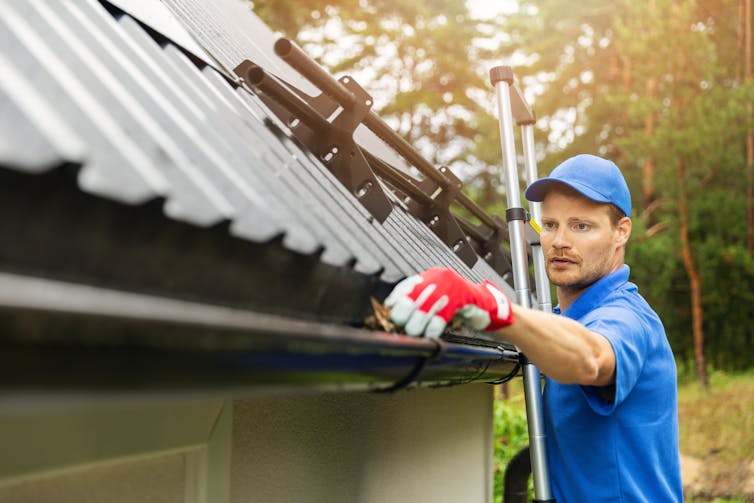
It’s time to look at preventative fire measures the same way we look at preventative healthcare.
Our taxes fund Medicare and public health measures because Australian society recognises it’s cheaper in the long run. It’s cheaper than allowing low-level health problems to fester until they become so threatening they have to be dealt with in the mind-bogglingly expensive emergency department.
In the same way, subsidies for household bushfire preparation would help prevent the vast taxpayer expense incurred for emergency fire-fighting when fire strikes.
What Might The System Look Like?
The system could take many forms.
State governments already give vouchers to citizens to incentivise spending in one area. Think of the NSW government’s Active Kids or Creative Kids voucher systems, or its planned dining and entertainment voucher system.
So why not give vouchers you can use to pay someone to clear your gutters, mow your lawn or clear dry grass and other fuel loads?
Insurers could offer lower premiums to people who take action to reduce fire risk around their home by ember-proofing or installing gutter-guard, for example (in the same way there are insurance benefits if you make your house more resistant to being broken into).

Perhaps councils could offer lower rates for low-income people who, in exchange, pay for measures to reduce their fuel load.
Or we could have a bulk-billing system, where you can ask a service provider to assess your home’s risk and do basic fire load reduction, and it’s charged to a Medicare-style system.
To me, these ideas make a lot more sense than more punitive measures being considered in some places, where authorities could clear a fire risk around a house themselves and simply send the bill to the occupant or land owner.
The punitive system just puts more pressure on people who may not be able to afford to reduce their home’s fire risk, much less deal with going to court to dispute a bill they’ve been sent. It also means people are less likely to trust and cooperate with fire authorities.
That Sounds Expensive
Yes, I know these ideas are expensive. So is Medicare. So is the pension system. So is the public health response that helped Australia drive the COVID-19 epidemic into submission. But they’re worth it, aren’t they?
And do you know what else is expensive? Doing the same thing every year, even though it doesn’t work.
We have just been through an enormously expensive bushfire royal commission. And as fire expert Kevin Tolhurst points out here, we’ve had 57 formal public inquiries, reviews and royal commissions related to bushfires and fire management since 1939. A huge expense to taxpayers.
We know the cost of the Black Summer fires ran into the billions, with costs to the health system, individuals, businesses and emergency services.
Aerial fire suppression aircraft are expensive. Having 100-day firefighting campaign is an extraordinary drain on the public purse — and that’s before you even start counting the cost of economic disruption that comes with it.
It Sounds A Bit Radical
I know! But radical change is what’s needed — and it’s possible. In early 2020, I wrote it was time to re-arrange the Australian school calendar around fire seasons and people said this was crazy. But then a few months later we completely rearranged schooling around the pandemic — an idea that, in January, would have seemed completely unworkable.
It turns out radical change is possible when push comes to shove. And for climate change-related fire risk, push really has come to shove.
Our current system involves telling people to create “a defendable space” around your house. I’ve been on Google Earth to look to at how that’s played out in many bushland suburbs; you don’t need to be a genius to work out there they are not defendable spaces.
Climate change adaptation does feel radical, but it’s also necessary.
If we are sitting round going into a hotter, drier, more fire-prone world, what are we doing if we are not enabling people to adapt?
This story is part of a series The Conversation is running on the nexus between disaster, disadvantage and resilience. You can read the rest of the stories here.![]()
David Bowman, Professor of Pyrogeography and Fire Science, University of Tasmania
This article is republished from The Conversation under a Creative Commons license. Read the original article.
Worried about Earth's future? Well, the outlook is worse than even scientists can grasp

Anyone with even a passing interest in the global environment knows all is not well. But just how bad is the situation? Our new paper shows the outlook for life on Earth is more dire than is generally understood.
The research published today reviews more than 150 studies to produce a stark summary of the state of the natural world. We outline the likely future trends in biodiversity decline, mass extinction, climate disruption and planetary toxification. We clarify the gravity of the human predicament and provide a timely snapshot of the crises that must be addressed now.
The problems, all tied to human consumption and population growth, will almost certainly worsen over coming decades. The damage will be felt for centuries and threatens the survival of all species, including our own.
Our paper was authored by 17 leading scientists, including those from Flinders University, Stanford University and the University of California, Los Angeles. Our message might not be popular, and indeed is frightening. But scientists must be candid and accurate if humanity is to understand the enormity of the challenges we face.
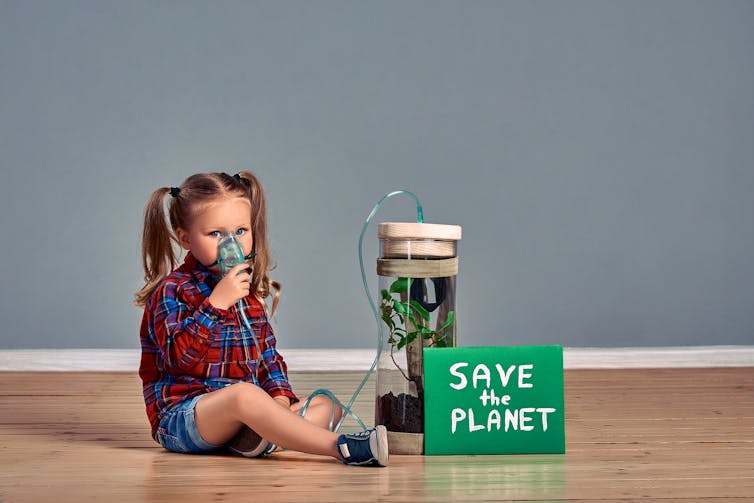
Getting To Grips With The Problem
First, we reviewed the extent to which experts grasp the scale of the threats to the biosphere and its lifeforms, including humanity. Alarmingly, the research shows future environmental conditions will be far more dangerous than experts currently believe.
This is largely because academics tend to specialise in one discipline, which means they’re in many cases unfamiliar with the complex system in which planetary-scale problems — and their potential solutions — exist.
What’s more, positive change can be impeded by governments rejecting or ignoring scientific advice, and ignorance of human behaviour by both technical experts and policymakers.
More broadly, the human optimism bias – thinking bad things are more likely to befall others than yourself – means many people underestimate the environmental crisis.
Numbers Don’t Lie
Our research also reviewed the current state of the global environment. While the problems are too numerous to cover in full here, they include:
a halving of vegetation biomass since the agricultural revolution around 11,000 years ago. Overall, humans have altered almost two-thirds of Earth’s land surface
about 1,300 documented species extinctions over the past 500 years, with many more unrecorded. More broadly, population sizes of animal species have declined by more than two-thirds over the last 50 years, suggesting more extinctions are imminent
Read more: What is a 'mass extinction' and are we in one now?
about one million plant and animal species globally threatened with extinction. The combined mass of wild mammals today is less than one-quarter the mass before humans started colonising the planet. Insects are also disappearing rapidly in many regions
85% of the global wetland area lost in 300 years, and more than 65% of the oceans compromised to some extent by humans
a halving of live coral cover on reefs in less than 200 years and a decrease in seagrass extent by 10% per decade over the last century. About 40% of kelp forests have declined in abundance, and the number of large predatory fishes is fewer than 30% of that a century ago.
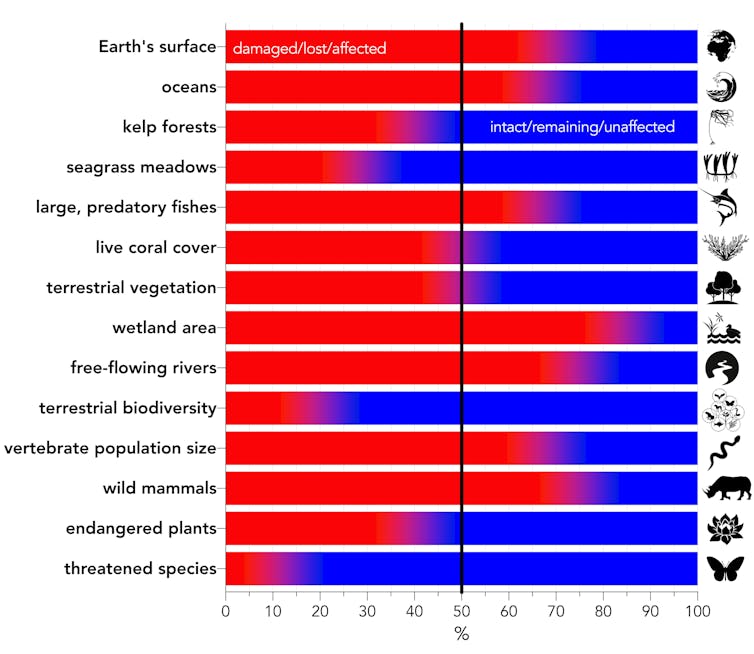
A Bad Situation Only Getting Worse
The human population has reached 7.8 billion – double what it was in 1970 – and is set to reach about 10 billion by 2050. More people equals more food insecurity, soil degradation, plastic pollution and biodiversity loss.
High population densities make pandemics more likely. They also drive overcrowding, unemployment, housing shortages and deteriorating infrastructure, and can spark conflicts leading to insurrections, terrorism, and war.
Read more: Climate explained: why we need to focus on increased consumption as much as population growth
Essentially, humans have created an ecological Ponzi scheme. Consumption, as a percentage of Earth’s capacity to regenerate itself, has grown from 73% in 1960 to more than 170% today.
High-consuming countries like Australia, Canada and the US use multiple units of fossil-fuel energy to produce one energy unit of food. Energy consumption will therefore increase in the near future, especially as the global middle class grows.
Then there’s climate change. Humanity has already exceeded global warming of 1°C this century, and will almost assuredly exceed 1.5 °C between 2030 and 2052. Even if all nations party to the Paris Agreement ratify their commitments, warming would still reach between 2.6°C and 3.1°C by 2100.

The Danger Of Political Impotence
Our paper found global policymaking falls far short of addressing these existential threats. Securing Earth’s future requires prudent, long-term decisions. However this is impeded by short-term interests, and an economic system that concentrates wealth among a few individuals.
Right-wing populist leaders with anti-environment agendas are on the rise, and in many countries, environmental protest groups have been labelled “terrorists”. Environmentalism has become weaponised as a political ideology, rather than properly viewed as a universal mode of self-preservation.
Financed disinformation campaigns, such as those against climate action and forest protection, protect short-term profits and claim meaningful environmental action is too costly – while ignoring the broader cost of not acting. By and large, it appears unlikely business investments will shift at sufficient scale to avoid environmental catastrophe.
Changing Course
Fundamental change is required to avoid this ghastly future. Specifically, we and many others suggest:
abolishing the goal of perpetual economic growth
revealing the true cost of products and activities by forcing those who damage the environment to pay for its restoration, such as through carbon pricing
rapidly eliminating fossil fuels
regulating markets by curtailing monopolisation and limiting undue corporate influence on policy
reigning in corporate lobbying of political representatives
educating and empowering women across the globe, including giving them control over family planning.
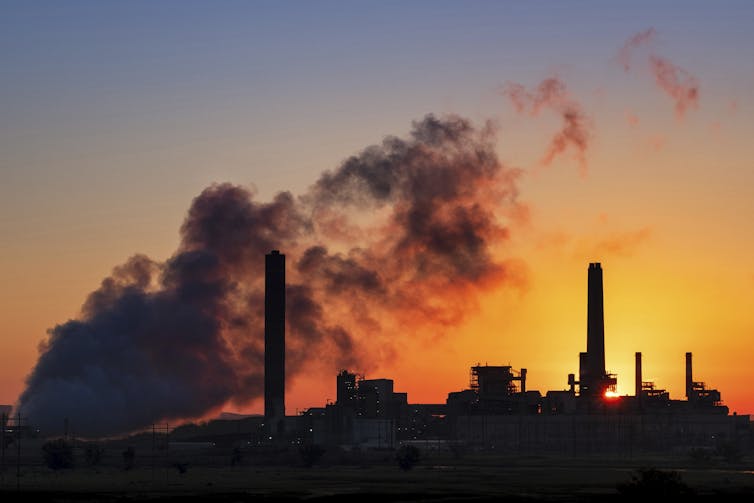
Don’t Look Away
Many organisations and individuals are devoted to achieving these aims. However their messages have not sufficiently penetrated the policy, economic, political and academic realms to make much difference.
Failing to acknowledge the magnitude of problems facing humanity is not just naïve, it’s dangerous. And science has a big role to play here.
Scientists must not sugarcoat the overwhelming challenges ahead. Instead, they should tell it like it is. Anything else is at best misleading, and at worst potentially lethal for the human enterprise.
Read more: Mass extinctions and climate change: why the speed of rising greenhouse gases matters ![]()
Corey J. A. Bradshaw, Matthew Flinders Professor of Global Ecology and Models Theme Leader for the ARC Centre of Excellence for Australian Biodiversity and Heritage, Flinders University; Daniel T. Blumstein, Professor in the Department of Ecology and Evolutionary Biology and the Institute of the Environment and Sustainability, University of California, Los Angeles, and Paul Ehrlich, President, Center for Conservation Biology, Bing Professor of Population Studies, Stanford University
This article is republished from The Conversation under a Creative Commons license. Read the original article.
Enjoy them while you can? The ecotourism challenge facing Australia's favourite islands
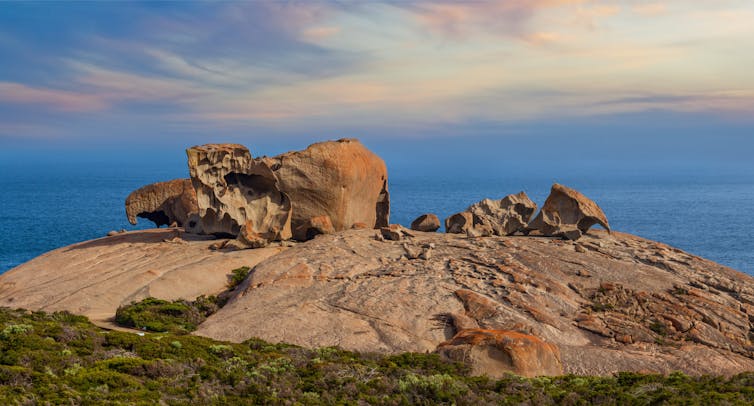
I fell for Kangaroo Island from my first visit. I recall standing on a headland on the island’s southern coast, near Remarkable Rocks (a popular tourist site), and being awestruck by the Southern Ocean.
The island (Australia’s third-largest after Tasmania and Melville Island) is one of 16 designated National Landscapes and arguably South Australia’s greatest tourism treasure. Its protected areas (notably Flinders Chase National Park) are home to rare and endangered marsupials and birds.
A year ago, in Australia’s “Black Summer”, bushfires ravaged more than half the island (about 211,000 hectares). Those fires underscored the threat to this and other iconic island destinations.
Both directly and indirectly, humans are endangering these fragile ecosystems through unsustainable development and human-caused climate change.
The most ironic threat is from unsustainable tourism. These islands attract millions of visitors a year keen to experience their natural wonders. Yet often this very “ecotourism” is contributing to their degradation.
How to do better?
Last October I took part in a workshop at which Kangaroo Island’s tourism operators discussed how to do so. 2020 was a difficult year for them, first with the fires, then with the COVID-19 pandemic. But in that adversity they also saw the opportunity to reset “business as usual” and come back better, creating an industry not harming its core asset.
Read more: The end of global travel as we know it: an opportunity for sustainable tourism
A range of ideas came out of our talks applicable to all our island destinations. But there was one key point. Ecotourism should be more than fleeting feel-good experiences. It should not be a “value extraction” but a “values education”, inspiring visitors to go home and live more eco-consciously.
Macquarie Island
The paradox of ecotourism is perhaps best exemplified by Australia’s least visited island destination – Macquarie Island, about 1,500 km south-east of Hobart, halfway between New Zealand and the Antarctica.
Just 1,500 tourists a year, rather than hundreds of thousands, are permitted by the Tasmania Parks and Wildlife Service to visit. The island has no hotels, restaurants or souvenir shops. The only buildings are those of the Macquarie Island Station research base and a few isolated field huts for scientists.
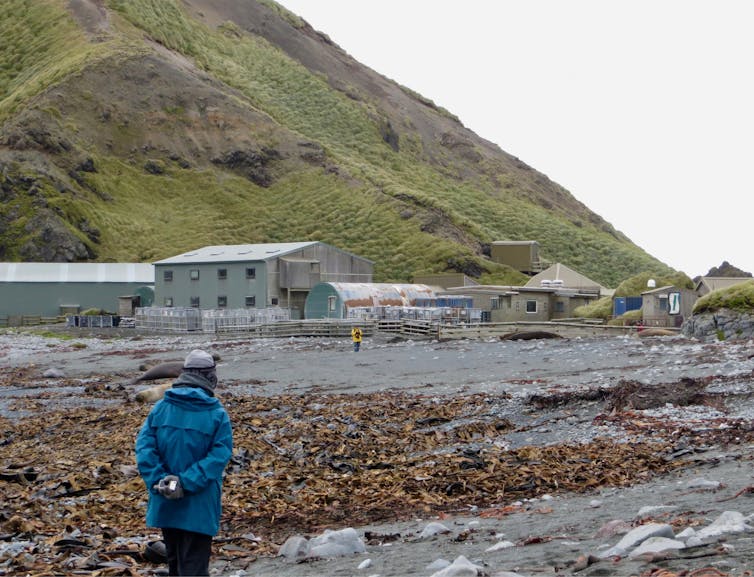
Tourists must be content with coming ashore for the day from the 18 small cruise ships that ply these waters in summer. The only hospitality is the traditional station offering of tea and scones.
But what tourists do get is a unique experience. Macquarie is World Heritage listed as the only island made entirely from the earth’s mantle. It also teems with wildlife – multiple species of penguins and seals in their tens of thousands, and birds in their millions.
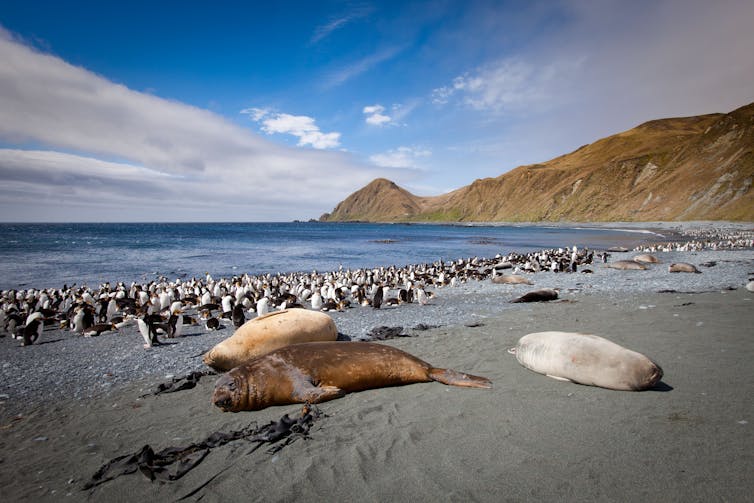
It’s about as pure an ecotourism experience you can have (if you can afford it). Even so, it still takes resources to get there, including the burning of fossil fuels, contributing to the global warming that is the greatest threat to the environmental integrity of Macquarie Island (and other island ecosystems).
However, the Tasmania Parks and Wildlife Service does at least expect cruise ship operators to “demonstrate their capacity to deliver desirable outcomes” on criteria including minimisation of environmental impacts and communicating to tourists “messages about the natural and cultural values of the island”, including the role they play in its preservation.
Read more: This could be the end of the line for cruise ships
K'gari (Fraser Island)
Communicating such messages is something that certainly needs improvement on another World Heritage listed island – K'gari (commonly known as Fraser island), the world’s largest sand island.
About 250 km north of Brisbane, at the southern end of the Great Barrier Reef, the island draws many hundreds of thousands of visitors a year to its beaches, woodlands and rainforests. (There are no recent public statistics on island visitor numbers but in 2017-18 the Fraser Coast region attracted 1,515,000 visitors.)
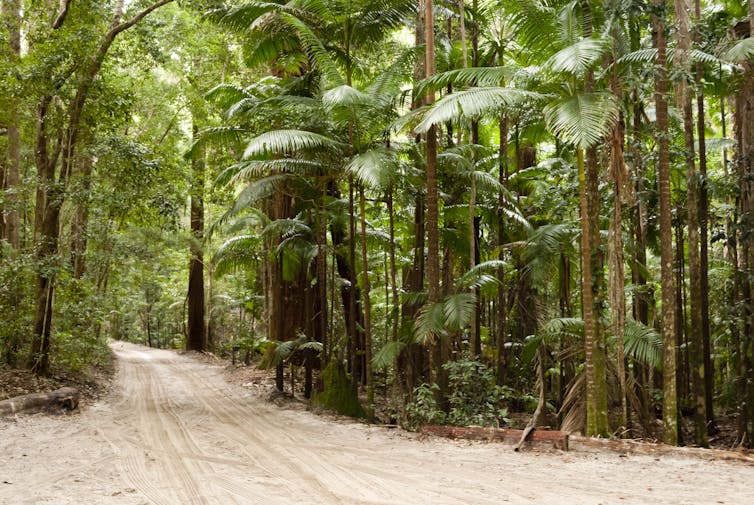
Once the island’s resources were mined and logged. Tourism was meant to be much less exploitative. But a range of organisations including the International Union for Conservation of Nature have highlighted the pressure tourist numbers (along with their vehicles and infrastructure) are placing on K'gari’s landscapes and wildlife.
Communicating to all those visitors the role they play in the island’s preservation appears to be failing. The bushfires that burnt half the island (about 165,500 hectares) over nine weeks between October and December last year allegedly resulted from an illegal camp fire.
Headline-grabbing attacks by the island’s residents dingos – such as in April 2019 when a toddler was dragged from a campervan – have also been credited to rampant irresponsible tourist behaviour (feeding dingoes to get better photos, for example).
Indigenous elders, conservationists and scientists have all pointed to the problem of a mass-tourism model that doesn’t put enough emphasis on educating visitors about the environment and their responsibilities.
Rottnest Island
One of our proposals for Kangaroo Island is to reduce the impact of motor vehicles through encouraging more extended walking and cycling experiences.
The value of sustainable transport as the foundation for ecotourism is demonstrated by Rottnest Island, 20 km off the coast of Perth.
The entire island is managed as an A-Class Nature Reserve. Apart from service vehicles and shuttle buses, it is car-free. You can hire a bike or bring your own to get around the island (11 km long and 4.5 km wide). Or simply walk.
The absence of traffic makes a Rottnest holiday a distinctly more relaxed experience. It’s a fair example of slow tourism; and, of course, it is also good for the island’s world famous quokkas, which co-exist with close to 800,000 visitors a year.
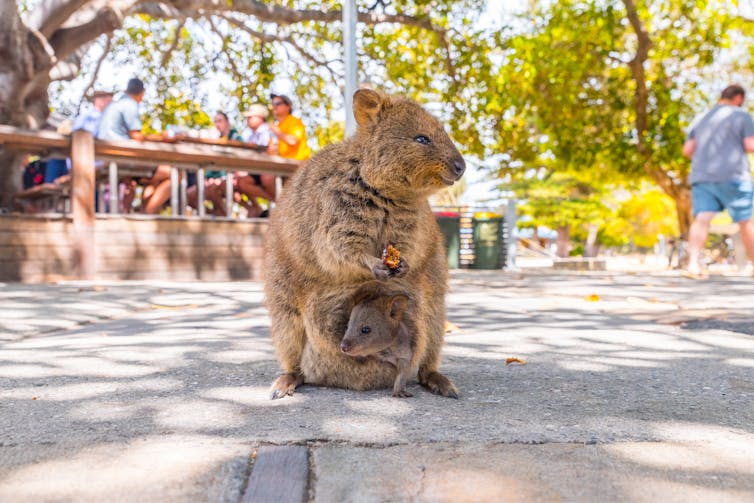
Read more: Before and after: 4 new graphics show the recovery from last summer's bushfire devastation
Before They Are Gone
Given a little space, nature is resilient.
After Kangaroo Island’s bushfires a year ago, for example, it was feared a number of endangered species had finally been driven to extinction.
But in two of 2020’s few good news stories, scientists found critically endangered Kangaroo Island dunnarts and little pygmy possums – the world’s smallest marsupial – had survived.

But we can’t take that resilience for granted if we keep putting pressure on these fragile ecosystems. We need a better approach to ensure ecotourism isn’t about enjoying these natural wonders before they are gone.![]()
Freya Higgins-Desbiolles, Senior Lecturer in Tourism Management, University of South Australia
This article is republished from The Conversation under a Creative Commons license. Read the original article.
 Shorebird Identification Booklet
Shorebird Identification Booklet
The Migratory Shorebird Program has just released the third edition of its hugely popular Shorebird Identification Booklet. The team has thoroughly revised and updated this pocket-sized companion for all shorebird counters and interested birders, with lots of useful information on our most common shorebirds, key identification features, sighting distribution maps and short articles on some of BirdLife’s shorebird activities.
The booklet can be downloaded here in PDF file format: http://www.birdlife.org.au/documents/Shorebird_ID_Booklet_V3.pdf
Paper copies can be ordered as well, see http://www.birdlife.org.au/projects/shorebirds-2020/counter-resources for details.
Download BirdLife Australia's children’s education kit to help them learn more about our wading birdlife
Shorebirds are a group of wading birds that can be found feeding on swamps, tidal mudflats, estuaries, beaches and open country. For many people, shorebirds are just those brown birds feeding a long way out on the mud but they are actually a remarkably diverse collection of birds including stilts, sandpipers, snipe, curlews, godwits, plovers and oystercatchers. Each species is superbly adapted to suit its preferred habitat. The Red-necked Stint is as small as a sparrow, with relatively short legs and bill that it pecks food from the surface of the mud with, whereas the Eastern Curlew is over two feet long with a exceptionally long legs and a massively curved beak that it thrusts deep down into the mud to pull out crabs, worms and other creatures hidden below the surface.
Some shorebirds are fairly drab in plumage, especially when they are visiting Australia in their non-breeding season, but when they migrate to their Arctic nesting grounds, they develop a vibrant flush of bright colours to attract a mate. We have 37 types of shorebirds that annually migrate to Australia on some of the most lengthy and arduous journeys in the animal kingdom, but there are also 18 shorebirds that call Australia home all year round.
What all our shorebirds have in common—be they large or small, seasoned traveller or homebody, brightly coloured or in muted tones—is that each species needs adequate safe areas where they can successfully feed and breed.
The National Shorebird Monitoring Program is managed and supported by BirdLife Australia.
This project is supported by Glenelg Hopkins Catchment Management Authority and Hunter Local Land Services through funding from the Australian Government’s National Landcare Program. Funding from Helen Macpherson Smith Trust and Port Phillip Bay Fund is acknowledged.
The National Shorebird Monitoring Program is made possible with the help of over 1,600 volunteers working in coastal and inland habitats all over Australia.
The National Shorebird Monitoring program (started as the Shorebirds 2020 project initiated to re-invigorate monitoring around Australia) is raising awareness of how incredible shorebirds are, and actively engaging the community to participate in gathering information needed to conserve shorebirds.
In the short term, the destruction of tidal ecosystems will need to be stopped, and our program is designed to strengthen the case for protecting these important habitats.
In the long term, there will be a need to mitigate against the likely effects of climate change on a species that travels across the entire range of latitudes where impacts are likely.
The identification and protection of critical areas for shorebirds will need to continue in order to guard against the potential threats associated with habitats in close proximity to nearly half the human population.
Here in Australia, the place where these birds grow up and spend most of their lives, continued monitoring is necessary to inform the best management practice to maintain shorebird populations.
BirdLife Australia believe that we can help secure a brighter future for these remarkable birds by educating stakeholders, gathering information on how and why shorebird populations are changing, and working to grow the community of people who care about shorebirds.
To find out more visit: http://www.birdlife.org.au/projects/shorebirds-2020/shorebirds-2020-program
Aussie Bread Tags Collection Points

New Advocate For Children And Young People
Zoe Robinson has been appointed NSW Advocate for Children and Young People (ACYP) for five years following a productive 12-month stint while acting in the role.
Minister for Families, Communities and Disability Services Gareth Ward said Ms Robinson had worked hard to elevate the voices of young people throughout her career and would continue to be a strong voice for children and young people in NSW.
“Zoe Robinson is a champion for children and young people and I look forward to working closely with her to ensure the voices of young people are at the heart of Government decision making,” Mr Ward said.
The Advocate for Children and Young People promotes the wellbeing of children and young people across the State by engaging with them and encouraging their participation in decisions that affect their lives.
Minister for Mental Health, Regional Youth and Women Bronnie Taylor said Ms Robinson had also been instrumental in representing the views of young people in regional NSW.
“This year has been a tough one for kids in the bush and the ACYP has an important role in making sure the voices of regional youth are elevated through to the highest levels of Government,” Mrs Taylor said.
Ms Robinson has worked hard to support, listen and advocate for children and young people aged zero to 24 years across NSW with a particular focus on those doing it tough.
“I have the opportunity to learn from the experiences of children and young people every day. I look forward to continuing to bring focus to the issues that are important to children and young people in NSW and ensuring that they have a voice in the decisions that affect them,” Ms Robinson said.
The ACYP is an independent statutory office reporting to the NSW Parliament through the Parliamentary Joint Committee on Children and Young People.
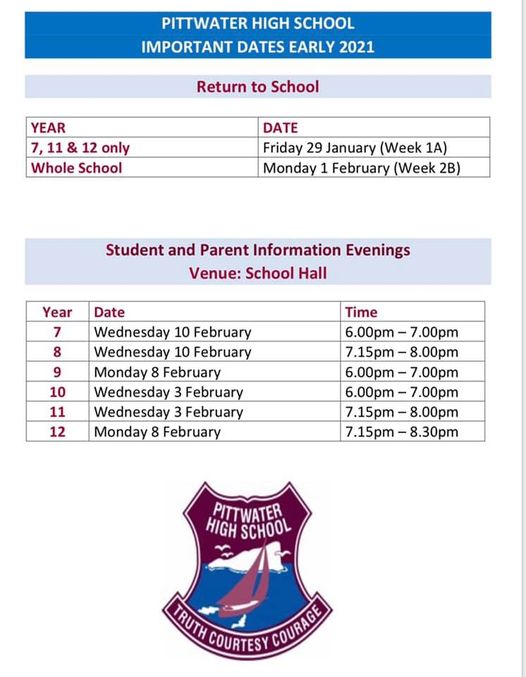
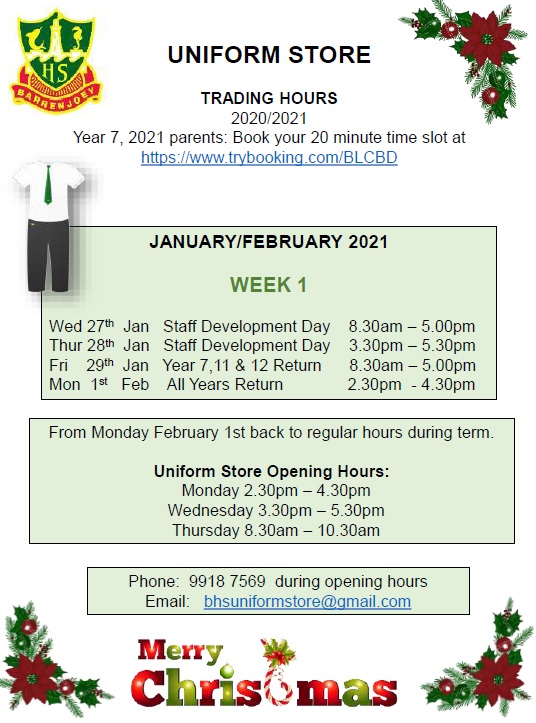
Winter Sports 2021 Registrations
Netball
Narrabeen Youth Club - Netball
NYC (Narrabeen Youth Club) Netball is a local family-oriented netball club for U8's to Senior players, with competition running through winter on a Saturday at John Fisher Netball Courts in Curl Curl.
All details on how to register are available on our website: https://www.nycnetball.com.au/
Mona Vale Commodores Netball Club
Register for our Come and Try Netball Day on Saturday 23rd January from 10:30-12pm. Session will be held at New Life Gym at 10 Jubilee Ave, Warriewood. Ideal for kids aged 5-12 years. Please book your child’s free ticket at www.trybooking.com/BNMSC
Local family friendly netball club based on the Northern Beaches of Sydney catering for all levels from NetSetGo to Seniors. Live local, play local. Established in 1969.
To register visit: http://www.monavale.nsw.netball.com.au/
Newport Breakers Netball Club
Visit: https://www.facebook.com/newportnetball
Email: newportbreakersnetball@gmail.com
Pittwater Peninsula Netball Club
Online registrations are now open!! Go to www.peninsulanetball.org.au and follow the links.
Tips before you start:
- have your MyNetball details handy (if unsure or applying for the first time visit mynetball.resultsvault.com)
- if you would like to use the 2021 Active Kids Voucher visit http://www.service.nsw.gov.au/.../apply-active-kids-voucher
- once you have your MyNetball number and your Active Kids Voucher head to our website and click on Register then follow the prompts.
Baseball
Pittwater Baseball Club
Pittwater Baseball Club has been part of the community for over 35 years and has a great reputation. Our club has seen many families through from Ratpackers (4-6 yr olds) to Adult Senior Leagues (16+), plus Masters and Minor Leagues over summer and winter. We are about having fun with friends, Making new ones, learning good sportsmanship, developing skills and making memories... Our home field is Rat Park in Warriewood and we are part of the Manly Warringah Baseball Association.
So come join us and have a go.
Junior Rugby League
Mona Vale Raiders
16 Bishop Street, Newport
The Mona Vale Raiders are one of the fastest growing and one of the most successful junior rugby league clubs in the Manly Warringah competition. Our home ground is Newport Oval, which is located between Bishop St and Barrenjoey Rd. Our club is a family club and as such we have a policy of giving all young people who are interested in playing rugby league a fair go. This emphasis has allowed us to be one of the most successful clubs in the Manly Warringah Junior Rugby League competition. The suburbs we cover are Mona Vale, Newport, Warriewood, Ingelside, Bayview, Church Point and Scotland Island. For more information please contact registrar@monavalerugbyleague.com.au
Narrabeen Sharks
In 2021 we will celebrate our 89th season. As the oldest and biggest club on the peninsular we have a long tradition of producing Junior Representative, First Grade and Australian Representative players. We have teams for every age group from Under 6s to Under 20s as well as Open Age A Grade and Over 35s Masters where we have players in their 60s. We are a community based club with a strong focus on family and inclusion. Our values are Honour, Respect, Loyalty, Integrity and Teamwork. Most of all we have FUN while developing our skills under qualified coaches in a safe environment. We accept Active Kids Vouchers so have your details ready. Come and make some lifelong friends while you play the greatest game of all with the Narrabeen Sharks. Email: sharksregistrar2101@gmail.com
Avalon Bulldogs
Avalon Bulldogs Junior Rugby League Club fields teams from Under 6's through to Open Age within the Manly Warringah District and NSW Northern Conference Competitions. Email: sambaum@optusnet.com.au
Junior Rugby Union
Newport Junior Rugby Club
We welcome registrations from kids of all abilities and all ages from U6 to U18.
To register your children to play for Newport Rugby Club, you will need to set up your MyRugby account and register your children online following the steps here.
If you have any questions with regards to your registration, please contact our registrar or one of your age managers ( details in our committee tab ).
Important Note: Register for “Newport Junior Rugby” not Newport Rugby which is the senior rugby club! For any u10 players and above you will need to upload a photo for match day records.
More at: https://www.newportjuniorrugby.com.au/registration/
Narrabeen Tigers Junior Rugby Club
Narrabeen Tigers Rugby is a family club that prides itself on providing a safe and happy atmosphere where boys and girls can play rugby with their mates and learn some great new skills along the way. We are affiliated with Warringah Junior Rugby Union, and are located adjacent to Warringah Seniors rugby (Pittwater Rugby Park) at North Narrabeen Reserve, North Narrabeen.
We have over 300 registered players, all the way from under 6 to under 17 year olds. We are also very proud to have grown the girls teams in our club. Girls of any age are welcome to play in mixed teams, however for under 8/9, under 11, under 13 and under 15, we offer girls only teams and comps. Most age groups will have 2 teams entered, allowing both serious and social players to enjoy their rugby with Tigers. All of our coaches are SmartRugby™ accredited.
2021 registrations are now open! Register before 31 December 2020 to use your 2020 Active Kids Voucher. For details on how to register click here. Registrations for girls competitions will open in the new year.
More at: https://www.narrabeenrugby.com.au/
Soccer
Narrabeen Football Club
Narrabeen FC, established in 1965, is one of Sydney Northern Beaches oldest football clubs, competing in the Manly Warringah Football Association. NFC’s focus is on the development of youth, fair play and competition. NFC fields teams from juniors through to senior. Register for 2021.
ONLINE registrations for the 2021 season open on 3 January 2021 for all players. Please make sure you read the instructions carefully before starting the process. Download a factsheet.
Registration – Before you start read this
Open from 3 January 2021
Register at www.playfootball.com.au. Please note, the website works best in Safari or Chrome.
Credit card payment only
*2021 season rego fees have been reduced due to a one off reimbursement from MWFA resulting from Covid-19.
Early Bird discount for all registrations received before midnight Friday 12 February 2021.
To claim the Active Kids Rebate, please visit the Services NSW Government website and obtain a claim number, BEFORE you register.
Read important information about player registrations, 2021 football season at Narrabeen FC and MWFA Instructions prior to registering.
Visit: http://www.narrabeenfc.com.au/register-and-play-football-with-narrabeen-fc/
Pittwater RSL Football Club
Pittwater RSL FC (Pride of the Peninsula) is looking forward to having you on board as a player and member of the Club. ‘Oh we love the greens’.
Registration for the 2021 Season is now open! Follow this link for a full run down of the rego process:
https://www.pittwaterrslfc.com.au/register-now/
Parents – Don’t forget to register for the Active Kids Rebate this year!
Avalon Soccer Club
2021 registration is now open. We are delighted to announce that registration for the 2021 MWFA season is officially open. With the grading and team forming due next month, we are offering an Early Bird discount of $25 for our members from the 4th January 2021 to 7th February 2021. This will be applied at the time of registering.
To register for Avalon Soccer Club head to the Play Football website. Full registration information for Avalon can be found HERE.
This season to process the large volume of registrations there are 3 registrars.
- Jactina Newcombe Juniors U6-U11 registrar@avalonsoccerclub.com.au
- Jill Thain Mixed U12-O55 registrar1avalonsoccerclub@gmail.com
- Amie Stylianou Womens W12-WO35 registrar2avalonsoccerclub@gmail.com
When asked to email information to the registrar please choose the relevant registrar for your age category. This will prevent delays in processing your registration.
Many teams fill up quickly and we will soon be closing off registration for some age groups. Any registrations after this time will be placed on a waitlist, pending sufficient players to create an additional team in that age group. Where possible, waitlisted players will be accommodated in an alternative age group (with returning players given priority). For any queries please get in touch with the relevant age coordinator.
Family Discounts
Parents registering their children under the same login can obtain a family discount for the 2nd plus family member. No discount applies for the first family member, then each of the other family members select from the following:
- 2nd family member $10 select 1st sibling
- 3rd family member $15 select 2nd sibling
- 4th family member $20 select 3rd sibling
- 5th family member $25 select 4th sibling
Student Discounts
Student discounts only apply to full-time adult student Student ID must be emailed to the registrar.
Coaches and Managers
All coaches and managers need to upload a photo and enter your working with children number, also please enter the team that you will manage or coach. All these fields are mandatory. Select the option Role Coach and both the Coach and Team Manager products will appear.
To be a coach or manager of a team with any players under the age of 18 you will need to have a valid working with children check before you can be issued your ID card. There must be a valid coach and manager for every team before they are permitted to play. You can apply for a working with children check here: https://www.service.nsw.gov.au/transaction/apply-working-children-check
If you already have a WWC check please make sure that the ‘valid to date’ will not expire during this season – apply for an updated check if that is the case.
Registration Information Day
Will be held at our club house at Careel Bay on Saturday 6th February 9:00am – 3:00pm.
If you have any questions about playing with Avalon (or would just like to meet us) then come along. The uniform store will be open on this day for any of your kit needs.
Active Kids Voucher
The Active Kids Rebate program provides a $100 voucher towards the cost of registration for U6 to U18 players. Players must obtain their voucher BEFORE registering. For more information about the Active Kids Rebate click here. To apply for your voucher from Service NSW click here. Vouchers are per child, not per family.
New Players
Welcome to all new players, especially if you are playing football for the first time. You will need to create an account and then register to play. We always try and place all our U6 and U7 players in the same team as their friends. If you have any questions, please contact your age coordinator.
Returning Players
All returning players MUST register with their FFA number from last year, not create a new number. The system will default to the club you last played at. If you played for a different club last season or played in a summer competition then remember to change the club to Avalon when registering.
If you have changed your email or forgotten which email you used to register last year then phone or email the Play Football helpdesk to assist you. Ph: 02 8880 7983 Playfootball.support@ffa.com.au
Registrations are based on the age that you will be on the 31st December 2021. For example, if you turn 7 anytime in 2021 you will then select U7 Mixed Saturday. To play in the U6s a child must be turning 5 or 6 anytime in 2021 and be born in either 2015 or 2016. This is an FFA rule.
Make sure you select the correct product when registering. Boys can only play in Saturday mixed competitions. Girls should register in a Sunday girls package if they want to play on Sunday.
More at: https://avalonsoccerclub.com.au/2021/01/04/2021-registration-is-open/
Digital Marketing Skills: Certificate IV In Marketing And Communications
January 11, 2020
TAFE NSW has introduced advanced digital marketing skills to its communications and marketing course to equip students and business owners with the skills needed to thrive in an online environment.
The TAFE NSW Certificate IV in Marketing and Communications will integrate key skills including digital marketing budgeting and market share optimisation through digital marketing tools in 2021, to equip students with the skills employers are looking for in a post-pandemic world.
The COVID-19 pandemic has seen a large reliance on digital marketing as organisations shift their businesses to online and introduce e-commerce as an integral part of the customer journey.
According to data from the Australian Bureau of Statistics, almost half of the Australian workforce — 46 per cent — was mainly working from home at the height of the pandemic, highlighting the reliance on digital marketing technology to connect to consumers.
TAFE NSW Head Teacher of Business Services, Susan Huntington, said TAFE NSW was on the front foot in order to make sure skills students are learning are closely aligned to industry needs.
“Throughout the pandemic, we have seen Australian businesses pivot to online without the skills needed to understand their online business model,” Ms Huntington said.
“TAFE NSW works closely with industry to identify what their skills needs are, and digital marketing is undoubtedly a skill that employers will look for in a post pandemic world.”
The Certificate IV in Marketing and Communications will allow students to learn from industry-experienced teachers on how to develop and communicate marketing strategies, conduct market research, analyse consumer behaviour and run digital marketing campaigns.
The course offers flexible delivery for students to study full-time, part-time or online with fee-free training options for those eligible for JobTrainer.
To enrol in a marketing and communications course at TAFE NSW, visit www.tafensws.edu.au or call 131 601.
The Christmas gifts that keep giving (your data away) — and how to prevent this

With the festive season having come to a close, consumers the world over will be playing with a variety of new tech toys.
In recent years, the most popular gadgets sold on Amazon have included a variety of smartphones, wearable tech, tablets, laptops and digital assistants such as Amazon’s Echo Dot.
And it’s likely our gifting habits over Christmas reflected this. But any device connected to the internet (including almost all of the above) exposes our personal data to a host of threats.
Few of us stop to consider how our new devices may impact our digital footprint, or whether they could build new channels between ourselves and cyber criminals.
With this in mind, here are some simple tips to help you lock down your digital footprint this year.
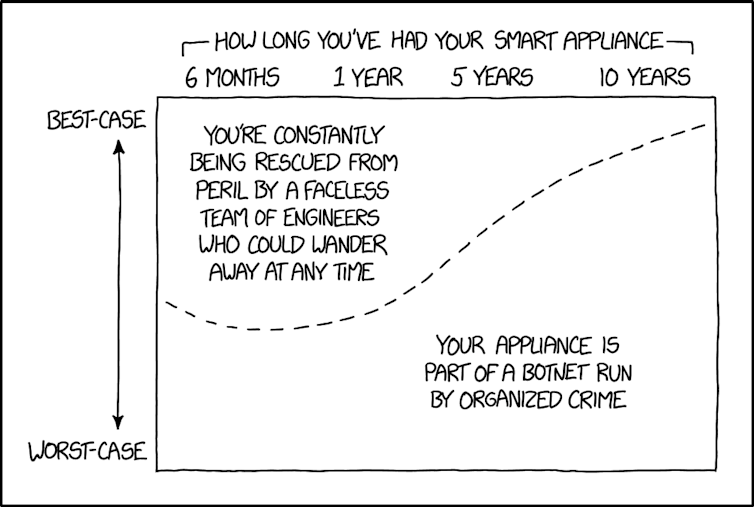
Use More Sophisticated Credentials
First, when it comes to setting up a new device and/or account, you should always use a unique password — every single time.
While this task may sound painful, it’s made much easier by password managers. Should your password for a particular account be stolen, at least the others will remain secure.
It’s also worth checking the Have I Been Pwned? website, which can reveal whether your online credentials have already been leaked.
Read more: A computer can guess more than 100,000,000,000 passwords per second. Still think yours is secure?
And even if you’re using more sophisticated biometric-based approaches on a device (such as face or fingerprint login), you can still leave yourself exposed by having a weak password that can allow hackers to bypass the biometric.
Also, if you ever have to enter a credit card number or other financial details to set up an account, you may want to remove them through the service provider’s site or app.
Some services require ongoing payments, but deleting stored payment details where they are no longer needed will help protect your finances. Most services will provide an option to do this, although others may require you to get in touch directly.
You Don’t Always Have To Be Transparent Online
We constantly provide our personal information online in exchange for access to accounts and services.
Often this includes date of birth (to validate your age), postcode (to offer regionally locked services) or details such as your mother’s maiden name (to help restrict unauthorised access to your account).
Consider having a fake identity. That way, if your details are stolen, your real data will be safe.
You may want to set up a sacrificial email account, or even a temporary address (also called a “burner email”) to sign onto services that are likely to spam you in the future.
Apple device users may want to explore the “Sign in with Apple” feature. This restricts the amount of personal data shared with a service is being used.
It can also hide the user’s actual email address when registering — instead creating a site-specific alias that can later be blocked if necessary.
Read more: Your personal data is the currency of the digital age
What Happens To Our Old Devices?
When new gadgets enter our lives, the old ones are often passed on to friends and family, sold to strangers, traded in, or simply recycled.
But before we discard our old devices into this growing technology mountain, we should make sure they’re clear of our data. Otherwise, selling an old phone may also mean inadvertently selling your private information.
Many modern devices, particularly smartphones and tablets, have a factory reset option that removes all user data.

For devices without a distinct wipe or reset option, you can consult with the user manual or manufacturer’s website (which will often have a copy of the user manual). If in doubt, there’s plenty of online advice on how to reset devices.
You may need to remove or unlink the old device from your online identities, such as your Apple ID.
It may also be necessary to delete cloud-based accounts — such as Dropbox or Google Drive — set up specifically for that device. And don’t forget about data stored on devices being returned to the seller (perhaps after Boxing Day sales).
A 2019 UK study examining second-hand phones on eBay found only 52% had been properly wiped or reset.
Moreover, 19% contained some form of personal information, ranging from active social media logins to bank account details.
Parental Responsibility
Children (especially those in primary school) who use devices should be educated on safe internet practices and cyber safety.
While younger people are becoming increasingly tech-savvy with time, they don’t necessarily know the risks associated with using internet-connected technologies.
It’s important for parents to first learn about appropriate safeguards, and then remind their children of them regularly.
Don’t Panic
The good news is you don’t need special cyber security training for each new tech purchase. The lessons above are transferable, so the key is simply to remember to use them.
There are plenty of sources for further learning, including UK Cyber Aware, the Get Safe Online initiative, and the Australian eSafety Commissioner’s website.
To quote from the film The Hitchhiker’s Guide to the Galaxy: “don’t panic”. Just think carefully about how you use (or get rid of) your devices from now on.![]()
Paul Haskell-Dowland, Associate Dean (Computing and Security), Edith Cowan University and Steven Furnell, Professor of Cyber Security, University of Nottingham
This article is republished from The Conversation under a Creative Commons license. Read the original article.
Look up! Your guide to some of the best meteor showers for 2021
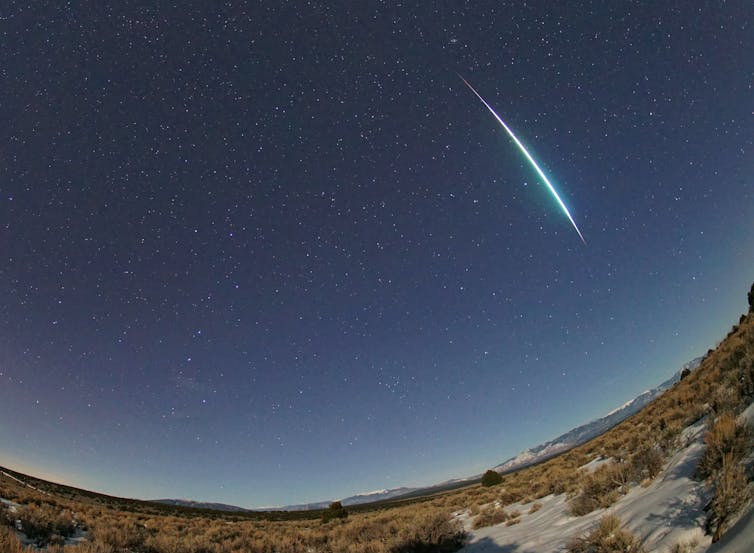
The best meteor showers are a spectacular sight but, unfortunately, 2021 starts with a whimper. Moonlight this January will wash out the first of the big three — the Quadrantids (seen above in 2020).
After that, the year just gets better and better, with the Perseids (another of the big three along with the Geminids) a particular highlight for northern hemisphere observers in August.
Read more: Explainer: why meteors light up the night sky
In addition to the year’s other reliable performers we’ve included one wild card: the Aurigids, in late August. Most years, the Aurigids are a very, very minor shower, but they just might put on a show this year.
So here is our pick of the meteoric highlights for 2021.
For each meteor shower, we give you a finder chart showing the radiant (where the meteors appear to come from in the sky) and where best to look in the sky, the full period of activity and the forecast peak. Most meteor showers typically only yield their best rates for about a day around maximum, so the peak night is definitely the best to observe.
The Zenithal Hourly Rate ZHR is the maximum number of meteors you would expect to see under perfect observing conditions. The actual number you will see will likely be lower.
Most meteor showers can only really be observed from either the northern [N] or southern [S] hemisphere, but a few are visible from both [N/S].
Lyrids [N/S; N Favoured]
ACTIVE: APRIL 14–30
MAXIMUM: APRIL 22, 1PM UTC = 11PM AEST (QLD) = 7AM CST = 3AM HAWAII TIME
ZHR: 18
PARENT: COMET C/1861 G1 THATCHER
The Lyrids are one of the meteor showers with the longest and most storied histories, with recorded observations spanning millenia. In the past, they were one of the year’s most active showers, with a history of producing spectacular meteor storms.
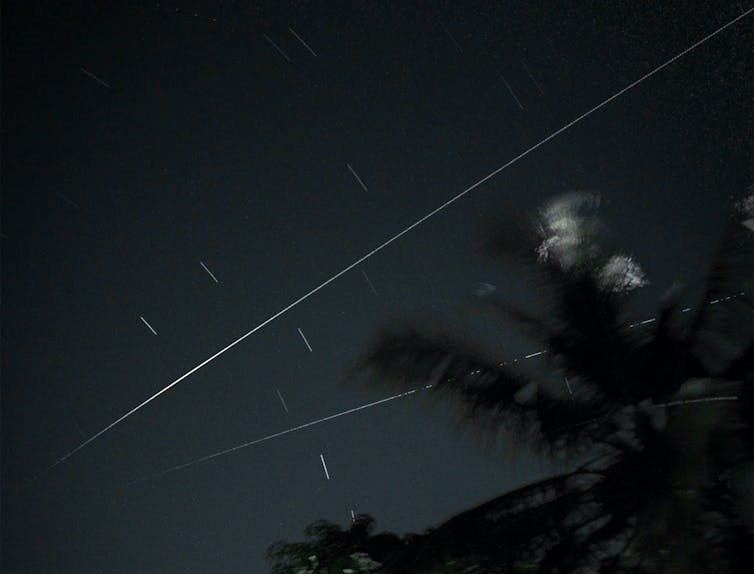
Nowadays, the Lyrids are more sedate, putting on a reliable show without matching the year’s stronger showers. They still throw up occasional surprises such as an outburst in excess of 90 meteors per hour in 1982.
This year’s peak Lyrid rates coincide with the first quarter Moon, which will set around midnight, local time, for most locations. The best time to observe will come in the early hours of the morning, after moonset.
For observers in the northern hemisphere, the Lyrid radiant will already be at a useful altitude by the time the Moon is low in the sky, so some brighter meteors might be visible despite the moonlight in the late evening (after around 10:30pm, local time).
Once the Moon sets the sky will darken and make the shower much easier to observe, yielding markedly higher rates.

For observers in the southern hemisphere, the Lyrid radiant reaches a useful altitude in the early hours of the morning, when the Moon will have set. If you’re a keen meteor observer, it could be worth setting your alarm early to get out and watch the show for a few hours before dawn.
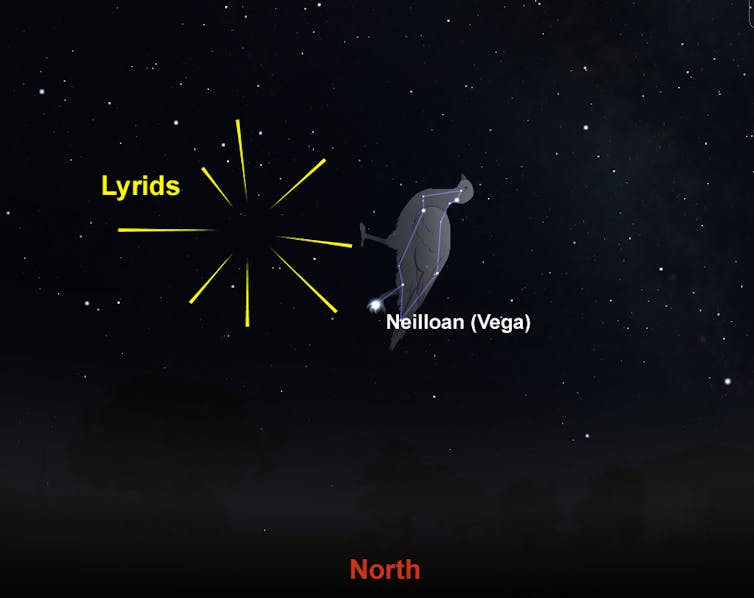
Lyrid meteors are fast and often quite bright so can be rewarding to observe, despite the relatively low rates (one every five or ten minutes, or so). Remember, this shower always has the potential to throw up an unexpected surprise.
Eta Aquariids [S]
ACTIVE: APRIL 19–MAY 28
MAXIMUM: MAY 6, 3AM UTC = 1PM AEST (QLD/NSW/ACT/VIC/TAS) = 11AM AWST (WA)
ZHR: 50+
PARENT: COMET 1P/HALLEY
The Eta Aquariids are an autumn treat for southern hemisphere observers. While not one of the big three, they stand clear as the best of the rest of the annual showers, yielding a fine display in the two or three hours before dawn.
The Eta Aquariids are fast meteors and are often bright, with smoky trains. They are fragments of the most famous comet, 1P/Halley, which has been laying down debris around its current orbit of the Sun for tens of thousands of years.
Earth passes through that debris twice a year, with the Eta Aquariids the best of the two meteor showers that result. The other is the Orionids, in October.
Where most meteor showers have a relatively short, sharp peak, the Eta Aquariids remain close to their best for a whole week, centred on the maximum. Good rates (ZHR > 30 per hour) should be visible before sunrise on each morning between May 3–10.
The Moon will be a waning crescent when the Eta Aquariids are at their best. Its glare should not interfere badly with the shower, washing out only the faintest members.
Observers who brave the pre-dawn hours to observe the Eta Aquariids will have the chance to lie beneath a spectacular sky. The Milky Way will be high overhead, with Jupiter, Saturn and the Moon high to the east and bright, fast meteors streaking across the sky from an origin near the eastern horizon.
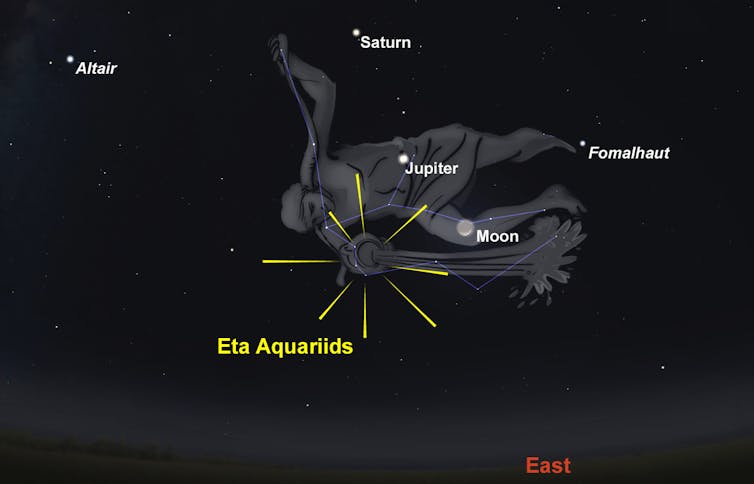
Perseids [N]
ACTIVE: JULY 17–AUGUST 24
MAXIMUM: AUGUST 12, 7PM–10PM UTC = 8PM–11PM BST = AUGUST 13, 4AM–7AM JST
ZHR: 110
PARENT: COMET 109P/SWIFT-TUTTLE
The Perseids are the meteoric highlight of the northern summer and the most observed shower of the year. December’s Geminids offer better rates but the timing of the Perseid peak makes them an ideal holiday treat.
The Perseids are debris shed behind by comet 109P/Swift-Tuttle, which is the largest known object (diameter around 26km) whose orbit currently intersects that of Earth.
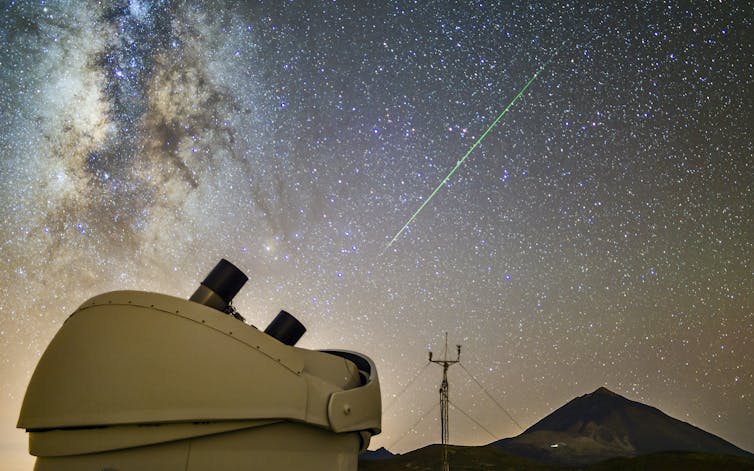
Perseid meteors are fast, crashing into Earth at a speed of about 216,000km/h, and often bright. While the shower is active, at low levels, for more than a month, the best rates are typically visible for at the three nights centred on the peak.
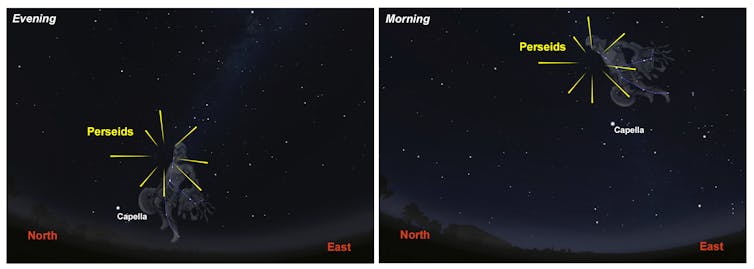
For observers at European latitudes, the Perseid radiant rises by mid-evening, so the shower can be easily observed from 10pm local time, and remains high all through the night. The later in the night you look, the higher the radiant will be and the more meteors you’re likely to see.
Aurigids [N Favoured]
ACTIVE: AUGUST 28–SEPTEMBER 5
MAXIMUM: POTENTIAL OUTBURST ON AUGUST 31, PEAKING BETWEEN 9:15PM–9:40PM UTC = 10:15PM–10:40PM BST = 11:15PM–11:40PM CEST = SEPTEMBER 1, 1:15AM–1:40AM GULF STANDARD TIME = SEPTEMBER 1, 5:15AM–5:40AM AWST (WA)
ZHR: 50–100 (?)
PARENT: COMET C/1911 N1 KIESS
Where the other showers are reliable and relatively predictable, offering good rates every year, the Aurigids are an entirely different beast.
In most years, the shower is barely visible. Even at its peak, rates rarely exceed just a couple of meteors seen per hour. But occasionally the Aurigids bring a surprise with short and unexpected outbursts of 30-50 meteors an hour seen in 1935, 1986, 1994 and 2019.
The parent comet of the Aurigids, C/1911 N1 Kiess, moves on an orbit with a period far longer than the parent of any other shower on our list.
It is thought the orbit takes between 1,800 and 2,000 years to complete, although our knowledge of it is very limited as it was only observed for a short period of time.
In late August every year, Earth passes through debris shed by the comet at a previous passage thousands of years into the past. In most years, the dust we encounter is very sparse.
But occasionally we intersect a denser, narrow stream of debris, material laid down at the comet’s previous passage. That dust has not yet had time to disperse so is more densely packed and hence gives enhanced rates: a meteor outburst.
Several independent research teams studying the past behaviour of the shower have all come to the same conclusion. On August 31, 2021, the Earth will once again intersect that narrow band of debris and an outburst may occur, with predictions it will peak around 21:17 UTC or 21:35 UTC.
Such an outburst would be short-lived. The dense core of the debris stream is so narrow it will take the Earth just ten or 20 minutes to traverse. So you’ll have to be lucky to see it.
The forecast outburst this year is timed such that observers in Eastern Europe and Asia will be the fortunate ones, with the radiant above the horizon. The waning Moon will light the sky when the radiant is above the horizon, washing out the fainter meteors from the shower.
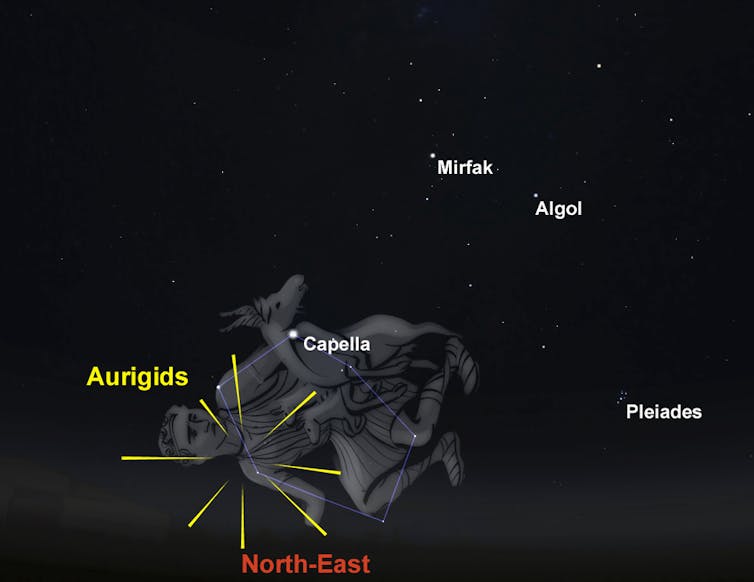

The Aurigids tend to be fast and are often quite bright. Previous outbursts of the shower have featured large numbers of bright meteors. It may just be worth getting up and heading outside at the time of the predicted outburst, just in case the Aurigids give us a show to remember.

Geminids [N/S]
ACTIVE: DECEMBER 4–17
MAXIMUM: DECEMBER 14, 7AM UTC = 6PM AEDT (NSW/ACT/VIC/TAS) = 3PM AWST (WA) = 2AM EST
ZHR: 150
PARENT: ASTEROID 3200 PHAETHON
The Geminid meteor shower is truly a case of saving the best until last. By far the best of the annual meteor showers, it graces our skies every December, yielding good numbers of spectacular, bright meteors.
The shower is so good it is always worth observing, even in 2021, when the Moon will be almost full.
Over the decades, the Geminids have gradually become stronger and stronger. They took the crown of the year’s best shower from the Perseids in the 1990s, and have continued to improve ever since.
For observers in the northern hemisphere, the Geminids are visible from relatively early in the evening, with their radiant rising shortly after sunset, and remaining above the horizon for all of the hours of darkness.
As the night progresses, the radiant gets very high in the sky and the shower can put on a truly spectacular show.
For those in the southern hemisphere, the situation is not quite as ideal. The further south you live, the later the radiant will rise, and so the later the show will begin.
When the radiant reaches its highest point in the sky (around 2am–3am local time), it sits closer to the horizon the further south you are, so the best meteor rates you observe will be reduced compared to those seen from more northerly locations.
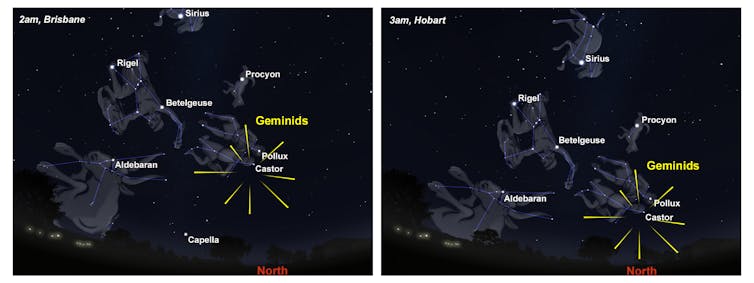
Despite these apparent drawbacks, the Geminids are still by far the best meteor shower of the year for observers in Australia, and are well worth a look, even on the moonlit nights of 2021.
Peak Geminid rates last for around 24 hours, centred on the official peak time, before falling away relatively rapidly thereafter. This means that observers around the globe can enjoy the display.
The best rates come when the radiant is highest in the sky (around 2–3am) but it is well worth looking up at any time after the radiant has risen above the horizon.

So wherever you are on the planet, if skies are clear for the peak of the Geminids, it is well worth going outside and looking up, to revel in the beauty of the greatest of the annual meteor showers.![]()
Jonti Horner, Professor (Astrophysics), University of Southern Queensland and Tanya Hill, Honorary Fellow of the University of Melbourne and Senior Curator (Astronomy), Museums Victoria
This article is republished from The Conversation under a Creative Commons license. Read the original article.
Why going for a swim in the ocean can be good for you, and for nature

Summer is the season when we like to cool off with a plunge into water. For some it’s in the local or backyard swimming pool, but others prefer the salt water of the ocean.
Sometimes referred to as “wild swimming”, it is happening at many of the beaches, coves, bays or estuaries in Australia.
Read more: Why should my child take swimming lessons? And what do they need to know?
But wild swimming is not only good for our health, it can also be good for ocean and beach ecologies too.
A Healthy Ocean Plunge
Annual competitive ocean swims, such as the Byron Bay Winter Whales and the Bondi to Bronte, are a mainstay of many Australian coastal towns and city suburbs. Daily and weekly recreational swimming groups are also well established at many of our beaches.
In European cultures, immersion in salt water has long been believed to be good for human health and seaside resorts there remain popular.
Ocean swimmers often wax lyrical about the health and wellbeing benefits they get from their regular ocean swims. And research from both the humanities and sciences backs up these claims.
It’s common to hear swimmers describe their troubles and anxieties washing away in the water. Like a daily cleansing, they emerge from their swim feeling energised, calm and ready to face their days.
Journalist and broadcaster Julia Baird has written about how her daily swims in Sydney inspire a sense of awe that shifts how she navigates other challenges in her life.
Other research talks about swimming as a process of “therapeutic accretion” whereby the pleasures of our regular short dips and longer swims in the ocean layer onto us and “build to develop a resilient wellbeing”.
In the UK, online movements such as #risefierce and Mental Health Swims promote regular swimming as a positive practice for our health and wellbeing.
Part of this is accepting that ocean conditions can change day to day. Some days are calm and clear, others are wild with waves and winds. If we want to swim, we have to learn to navigate the conditions we are dealt.
This capacity for decision-making in the face of challenge is helpful for a sense of confidence and resilience – something that has been clear during COVID-19 lockdowns around the world.
Encounters With The Wild
For swimmers, the water offers other rewards.
Swimming, like other ocean sports like surfing and diving, is a way of immersing us in ecologies and bringing us into contact with animals, plants, weather, waves and rocks in a way that we cannot control.
We may encounter fish, birds, rays, turtles, cephalopods and other animals. All are reported to help with a sense of wellbeing. This highlights how we are part of these ecologies too.
The recent film My Octopus Teacher resonated with many people who swim and who regularly encounter the same animals.
Some swimmers even relate the effect of swimming to animals that live in oceans. In a study on swimming in the UK, one swimmer explained how they “went in like a cranky sea lion and came out like a smiling dolphin”.
Care For The Oceans
Being part of an ecology means we have responsibilities too. In Australia, we need to take a lead from Indigenous Australian people to care for the sea country we swim in.
Ocean plastics, sewage and the antibiotics in agricultural run-off are a potential problem for our health as we swim in polluted oceans.
Our encounters with animals that live close to shore can impact their health too, so we need to remember to respect their space.
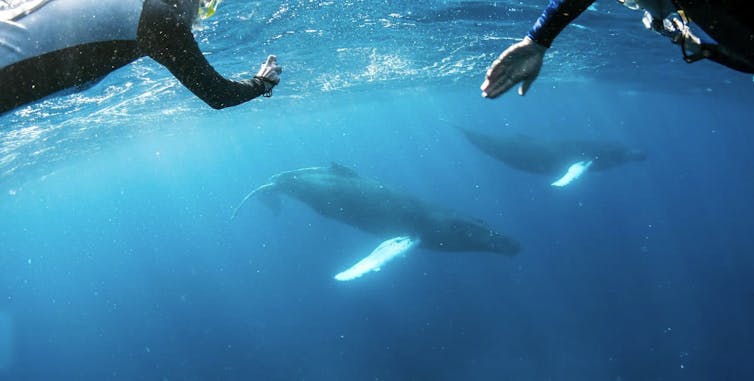
Many cultures are aware of the interconnections between people and the environments they live in. For example, Native Hawaiian and Māori researchers write about their links to oceans, and the Ama women in Japan connect with underwater soundscapes as they dive for abalone.
Read more: Swimming with whales: you must know the risks and when it's best to keep your distance
In Australia, Aboriginal and Torres Strait Islander people are deeply aware of the connections between the health of people and the land, sea and sky countries they live on.
People cannot be healthy if Country is not healthy, nor can Country be healthy if people are not.
And that’s why wild swimming could be good for ocean and beach ecologies too. The more we learn about the health and wellbeing impacts of ocean and coastal ecologies, the more we should feel invested in taking care of them.
Let’s Swim Together
The lack of control we have over conditions in ocean waters can be frightening, and the same encounters that thrill some people are terrifying for others.
Even for experienced swimmers, drowning is a very real risk. Between July 2019 and June 2020, 248 people drowned in Australia, with 125 of those coastal drowning deaths.
Read more: Shark nets are destructive and don't keep you safe – let's invest in lifeguards
For others their fear of shark attacks and encounters is enough to keep them out of ocean water.
So if you want to give the ocean a try this summer, many people find comfort and safety by wild swimming with others. This is reflected in the growth of swimming groups.
Websites such as oceanswims.com and Swim Sisters list ocean swimming groups and competition swims around Australia. It’s easy to find information through your local community too.
Swimming in the sea can be as simple as taking that first plunge in knee-deep water, or as challenging as an hours-long marathon along the coast. Whatever you prefer, take the time to enjoy being immersed in a watery world.![]()
Rebecca Olive, ARC DECRA Fellow, The University of Queensland
This article is republished from The Conversation under a Creative Commons license. Read the original article.
Girls Can't Surf shows how determined women battled sexism in their sport
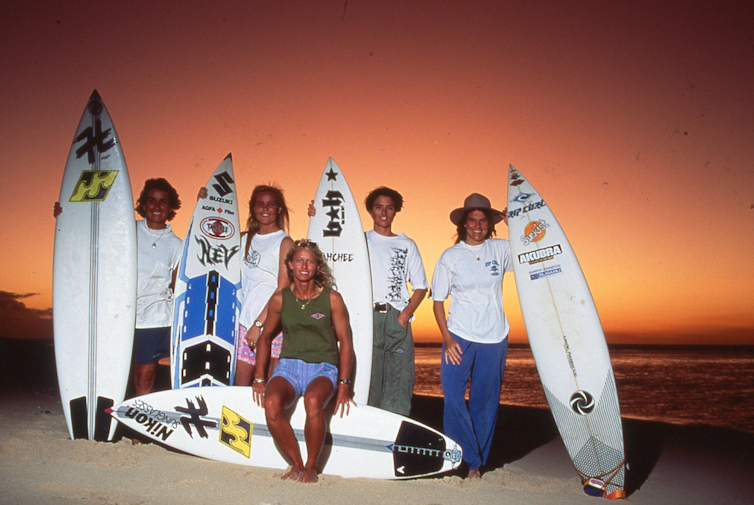
Review: Girls Can’t Surf, directed by Christopher Nelius
The documentary Girls Can’t Surf spans the 1980s and early 1990s as women surfers battled in and out of the ocean. It has the predictable surf movie elements — a countercultural vibe and lots of fluoro fashion — but its power comes from the untold stories of brave, tenacious and funny women who fought to be taken seriously in their sport.
In the 1980s, a fierce international group of determined women surfers decided enough was enough in the battle against sexism and unequal pay. The film highlights the fight on and off the waves that contributed to women surfers’ eventual 2019 equal pay deal with the World Surf League.
Read more: Women’s surfing riding wave towards gender equity
Christopher Nelius (director, writer and producer) and Julie Anne De Ruvo (co-writer) have sourced an unbelievable series of clips, likely dug out of garages the world over, combining previously unseen footage with brutally honest interviews.
The women interviewed include Australians Jodie Cooper, Pam Burridge and Layne Beachley; South African Wendy Botha and Americans Frieda Zamba, Lisa Andersen and Jorga and Jolene Smith. They speak frankly of the fight for equality in a chauvinistic time, their struggles in the surf and their own coming of age.
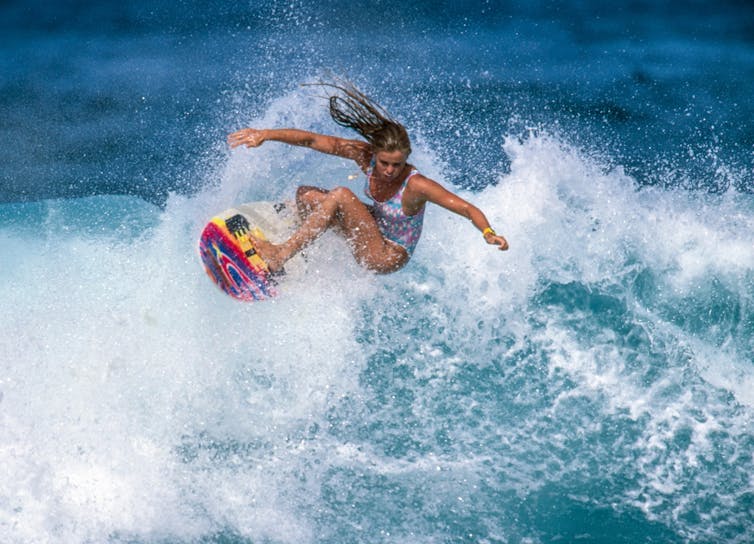
In the early years of competitive surfing, the sentiment of these women could be summarised as we will succeed despite. As the film tells, pioneering women surfers earned a tenth of the prize money and were at times relegated to holding contests during the men’s lunch breaks.
Inferior Waves
The film highlights how much of the sport’s early focus was on how women looked. Speaking of women surfers in the 1980s, Damien Hardman, former surfing world champion, said, “I think they just need to look like women. Look feminine, attractive and dress well.”
Pam Burridge, the world champion in 1990, observes: “I got some flack that you girls need to lose weight or else the whole sport would fail.”

It was hard for competing women to get the chance to even surf proper waves. Jorja Smith, former pro surfer and rookie of the year in 1985-86, describes men surfing the best waves while women were left with “this shitty, hell-hole, scum pit [part] of the ocean” with onshore winds.
The surf conditions provided to these women were part of the bigger picture of respect and equality, or lack of it at the time. Although pay is the most visible topic in discussions of sports equality, broader respect for women’s competitions and the provision of support services are just as important.

You can’t help but cringe as the film flashes back to 1989, when organisers of the Huntington Beach OP Pro in California decided to drop the women’s event to provide more prize money to the top 30 male surfers. (But, of course, keep the bikini contest). After an outcry led by the Smith twins, the OP relented, reinstating the women’s event.
Read more: Hidden women of history: Isabel Letham, daring Australian surfing pioneer
‘Lacking Permission’ But The Tides Will Change
An oft-stated argument at the time was that women surfers didn’t bring in the money through sponsorships from companies such as clothing brands — they didn’t sell bikinis the way male surfers sold board shorts.
But in 1993, Quicksilver discovered there was a shortage of the smallest size of boardshorts — because women were buying and wearing the men’s gear. It started a dedicated women’s surf wear brand called Roxy, which turned over US$600 million in just four years.
This film shows how women in surfing faced sexism and social backlash as they advocated for their rights, better pay, visibility and sponsorship deals.
As surf writer Nick Carroll observes:
The girls who got into pro-surfing in the early 1980s were pretty much exactly the same as the boys. They had the same dreams, the same visions but they didn’t have the permission of the surf culture.
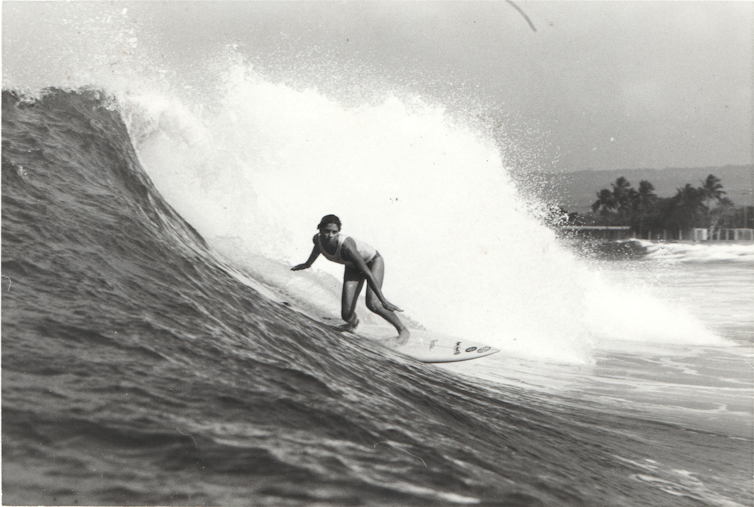
Girls Can’t Surf cements the idea that sport is a microcosm for society. The 1980s was a time of stark contrast: of bikini contests on the beach versus the “power suit”. For women surfers, the swimsuit was at the centre of their battle.
The skimpy bikinis they were required to wear in contests tended to go awry while competing, ending in “an enema so bad, I thought I was going to die”, in the unforgettable words of Jodie Cooper, an ex pro-surfer from West Australia, known for her ability to surf big waves. (Sadly, big waves were in short supply for women competing at that time).
Girls Can’t Surf has an ebb and flow, like the ocean’s tides. There is, at times, a sense of two steps forward, one step back. In 1999, for instance, at Jeffrey’s Bay in South Africa, women surfers were sent out to compete in a heat when there were no waves. They refused to paddle out — instead, collectively sitting at the water’s edge. This moment was regarded as a turning point.
Yet as these women show, a few passionate and dedicated people can be the start of a movement that changes history. At this year’s Tokyo Olympics, surfing events for both men and women will make their debut.
Girls Can’t Surf will premiere at the Perth Festival on January 11, at Sydney Film Festival on January 17 and be released in Australian cinemas nationally in March, 2021. The Sydney screening screening will be attended by special guests Layne Beachley, Jodie Cooper, Pam Burridge, Pauline Menczer, and Christopher Nelius.![]()
Sophia Nimphius, Professor of Human Performance, Edith Cowan University
This article is republished from The Conversation under a Creative Commons license. Read the original article.
Flip flop: the un-Australian history of the rubber thong

The shoe known in Australia as a “thong” is one of the oldest styles of footwear in the world.
Worn with small variations across Egypt, Rome, Greece, sub-Saharan Africa, India, China, Korea, Japan and some Latin American cultures, the shoe was designed to protect the sole while keeping the top of the foot cool.
Australians have long embraced this practical but liberating shoe — but history shows we can’t really claim to it as our own.
Read more: The erotic theatre of the pool edge: a short history of female swimwear
Geishas, Workers, Soldiers
Japan is often cited as the pivotal influence, perhaps because the culture features not only the thong’s closest ancestor (the flat-soled zori, traditionally made from straw) but also the chunky geta sandal, famously worn by geisha for centuries in an effort to keep trailing kimono hems out of the mud.

In the late 19th century, Japan started to export aspects of its culture to diverse corners of the world. An early example was the Hawaiian “slipper” or “slippah”, a thong-like version of the zori with roots in the footwear of Japanese plantation worker immigrants in the 1880s. The slipper rapidly became part of the Hawaiian sartorial code (as in Australia, the shoe suited the relaxed outlook and beach lifestyle).
The popularity of the shoe may have spread after US soldiers, stationed in the East Pacific during the second world war, brought back souvenirs — but that claim is contested.
During the 1940s the technology for mass-producing synthetic rubber was developed, and this undoubtedly increased dissemination and influence of the humble flip flop. However, it was not until around the same time Hawaii became the official 50th state of the USA in 1959 that thongs became a globally recognised symbol of leisure.
Downunderfoot
Despite the thongs’ strong identification with Australia, details of its exact arrival here are not easy to pin down.
From 1907 onwards, for example, advertisements described “Japanese sandals” with “flexible wooden” or jute soles, although the few illustrations that exist do not depict shoes with a thong fastening.
In 1924, Melbourne’s The Herald discussed criticism levelled at Melburnians for walking with a “flip-flop movement, bringing the back of the heel down too heavily on the ground, causing jarring to the body and fatigue”.
Heels were suggested as a remedy for women with this complaint. Nearly a century later, podiatrists still recommend avoiding thongs for long term wear. (These days, they’re not fans of heels either.)

In 1946, department store David Jones promoted “Olympia”, a Greek-inspired thong sandal with additional ankle straps. But it was not until around 1957, when Kiwi businessmen Maurice Yock and John Cowie both claimed credit for what they termed the “jandal” — a portmanteau of “Japanese” and “sandal” — that Australia’s connection with the flip flop became more established and, at the same time, questioned.
In 1959, Dunlop in Australia imported 300,000 pairs of thongs from Japan. They started producing them internally in 1960.

Read more: Take a plunge into the memories of Australia's favourite swimming pools
As Australia’s tourism boomed during the 1950s and 60s, so too did its sartorial image, with thongs taking centre stage as the footwear of choice for an egalitarian, laid-back society.
So widespread did they become, in fact, that by the mid 1960s bans were being sought by state governments to avoid frequent injuries at the workplace — especially construction sites.
In the name of professionalism, in 1978 the Queensland government decreed that schoolteachers not be permitted to wear thongs to work. This year, they have been banned for wear at Australia Day citizenship ceremonies — a decision reflecting a wish for greater “significance and formality” to be represented at official events.
But the rubbery love affair endured, perhaps shown most ardently when Kylie Minogue made her entrance as part of the Sydney 2000 Olympics atop a giant rubber thong carried by lifeguards.
Dressing Up, Dressing Down
Thong-related concerns have not been limited to Australia.
In 2005 members of an American college women’s lacrosse team wore them to the White House to meet President Bush. There followed a furor over whether this brazen act was disrespectful, a distraction from the women’s achievements or signalled a casual shift in attitudes to leaders (and fashion) in the years after the Clinton sex scandals.

Since the late 1990s it has been possible to buy more formal heeled versions. Although these were widely mocked as expensive aberrations of the style, they looked to making a Kardashian-led comeback in recent times.
Branded versions are also available, with couturiers like Hermès selling a very unassuming flip flop for a cool A$600.
There is a poignant irony in the fact that thongs are the most popular kind of shoe in developing countries, precisely because of their cheap manufacture (often made from recycled rubber tyres) and consequently, very low purchase cost.
This practice of appropriating “ordinary” or “working class” clothing — transitioning it from the practical to the fashionable — is nothing new. We’ve seen it with singlets and boilersuits. Clogs are another footwear example.

Rather than a form of fashion whimsy, Australians take their thongs seriously. Even the naming of them — after the structural make-up of the shoe’s fastening rather than the onomatopoeic “flip flop” used by other countries — flies in the face of the Australian preference for shortened diminutives and nicknames.
That shows true commitment, but also that thongs are not really so dinky-di, after all.
Read more: Friday essay: vizards, face gloves and window hoods – a history of masks in western fashion ![]()
Lydia Edwards, Fashion historian, Edith Cowan University
This article is republished from The Conversation under a Creative Commons license. Read the original article.
Mary Shepard: the artist who brought Mary Poppins to life

The success of Disney’s 1964 movie Mary Poppins has often obscured the fact the popular series of books describing the experiences of the enigmatic nanny were in fact written by the Australian born author P.L. Travers.
Travers’ own sense of ownership of her creation in turn obscured the contribution made by the illustrator Mary Shepard. Despite a 54 year collaboration, Shepard is regularly ignored in discussions of the books: the 2013 movie Saving Mr Banks, which detailed the genesis of the film, did not even mention Shepard or the pivotal role she played in the books’ success.
Shepard was born in Sussex on Christmas Day in 1909, the only daughter of Florence Chaplin, a painter, and E.H. Shepard, who illustrated Winnie the Pooh and the Wind in the Willows. Her mother died suddenly in 1927, and that same year Mary was accepted into the Slade School of Art where she studied painting and drawing.
Even as a new author, Travers was never one to sell herself short, wanting E.H. Shepard to illustrate the first Mary Poppins story. He declined, too busy with other drawing commissions, but fortuitously Travers saw Mary’s artwork on a Christmas card and felt her whimsical style was well suited to her vision for Mary Poppins.
Shepard had recently graduated and was invariably humble about her talents. Travers was ten years her senior and far surer of herself. She saw the illustrations as servants of the text rather than artworks in their own right.
Read more: How Australia's children's authors create magic on a page
This view would colour their whole working relationship.
Years later, Shepard recalled the struggle to create an appropriate “Mary Poppins”. In her typically self-effacing style, Shepard wrote in her unpublished biography it was finally achieved “after some effort and a lot of help and advice from Pamela.”
The inspiration for Shepard’s initial sketches was a wooden Dutch doll owned by Travers.
Travers did not want Mary Poppins to be beautiful: Shepard wrote she was directed to make Mary Poppins “totally bosomless, as flat as a board, which as a character seemed to suit her best!”
But in later drawings there is a visual change, perhaps reflecting Shepard’s growing confidence. Poppins becomes prettier, more feminine, and eventually Shepard goes so far as to transpose her own features onto Poppins’ face.
A Difficult Relationship
Shepard’s family background and her humility were perhaps the main reasons why the long collaboration with the notoriously prickly Travers was even possible, with Shepard illustrating all eight Mary Poppins books from 1934 to 1988.
But Travers’ desire to exert artistic control is evident in letters and notes on Shepard’s preliminary sketches.
Writing about their relationship in 1980, Travers said: “the word, as it appears in print, needs to be served by both writer and artist, mutually and in harmony”. But closer to her real view was expressed in a letter to her agent, Harriet Wasserman: “what counts most is text, not picture”.
Ultimately, this ensured this long and financially successful collaboration with Shepard was often an unhappy one. Closer to the truth than Travers’ self-serving assessments is publisher Frank Eyre’s observation, that, because the character of Mary Poppins is so important:
Mary Shepard’s illustrations are of the first importance too, for they present Mary Poppins to us visually in a way that establishes her for ever.
The £1,000 Feet
The relationship between Shepard and Travers came under particular pressure with the release of the Mary Poppins film.
Disney spent decades trying to reach an arrangement with Travers, and though Travers hated the film, it was – for her and Disney at least – financially very lucrative.
Shepard did not initially receive any financial benefit from the film, nor was Travers supportive of her efforts to do so.

Her agent A.S. Knight finally succeeded in winning Shepard £1,000 for the unique portrayal of Mary Poppins’ feet in the first ballet position as she descends from the sky.
The placement of the feet, which Shepard described as portraying the “firm implacable stance which seemed to indicate Mary Poppins herself”, was inseparably associated with her creation of Mary Poppins’ image.
I’ll Stay Till The Wind Changes
Shepard was a talented artist who also illustrated Ruth Manning-Sanders’ Adventure May be Anywhere (1939) and A. A. Milne’s Prince Rabbit and The Princess Who Could Not Laugh (1966).
In 1937, she married E.V. Knox, the editor of Punch magazine who her father worked for as an illustrator and political cartoonist. It was a happy union, with Knox often standing in as a model for Mr Banks in Shepard’s drawings.

Mary Shepard died in September 2000, and her grave is beside her stepdaughter the writer Penelope Fitzgerald, who was only seven years younger and to whom she was very close.
Fitzgerald’s headstone depicts a hand with a pen. Shepard’s has a hand holding a paintbrush. A fitting tribute.![]()
Margaret Baguley, Professor in Arts Education, Curriculum and Pedagogy, University of Southern Queensland and Martin Charles Kerby, Associate Professor Curriculum and Pedagogy, University of Southern Queensland
This article is republished from The Conversation under a Creative Commons license. Read the original article.
3 reasons to study science communication beyond the West

Ask a science communicator how old their field is. They might say a few decades, or even centuries, because they’re thinking about the Western science communication tradition associated with a scientist-public gap.
These days, we almost exclusively associate science communication with Western science. Yet humans have always communicated knowledge about the world within their own societies and to others. There’s evidence of this going back tens of thousands of years.
Society today should recognise past and ongoing science communication approaches that diverge from the West’s relatively recent ones.
Also, as we have explored in a paper and webinar, we should include this knowledge in science communication histories. Here are three reasons why.
1. Framing Science As ‘Western’ Is Political
The histories we tell are political. Political factors can determine important elements such as where a story begins and ends and what is included or excluded. Histories of science aren’t immune to this.
We often equate science and scientific practice with a gold standard of credibility. But there’s much rhetorical power behind the “science” label.
Some influential 20th-century scholars, such as the late British historian Herbert Butterfield, valorised Western science and judged other sources of human knowledge production as failed attempts.
Others such as Andrew Cunningham, while trying to redress that tendency, defined “science” so narrowly that only the Western version of professional knowledge production applied.
Read more: It's taken thousands of years, but Western science is finally catching up to Traditional Knowledge
Both these stances denigrate non-Western knowledge systems as lesser, by excluding them from “science”.
They have shaped science communication histories taught today, wherein we mostly ignore the diverse ways in which cultures across the world have communicated knowledge.
Thus, most science communicators lack insight into how these cultures tailored their communication to different audiences, aims and mediums.
Did you know medieval European medical writers regularly used Arabic pseudonyms for their published works to confer prestige?
This was because, at the time, Arabic cultures demonstrated strong leadership in pharmaceuticals and other scientific fields across the Afro-Asian-European landmass.
Or consider the Persian engineers who built ingenious constructions to provide water, air conditioning and refrigeration to desert communities thousands of years ago.
They communicated their technical expertise over generations through spoken word and actions.

Such snippets offer deep insight into myriad science communication cultures. Unfortunately, they’re rarely included in science communication histories today.
To borrow from Peter Pormann, a professor of Classics and Graeco-Arabic Studies at the University of Manchester, this is a case of intellectual amnesia.
It may be historians’ wish to respect diverse cultural categories, since “science communication” is an English term associated with Western culture. But a side effect of this is a profoundly Eurocentric approach.

2. Human Cultures Are Diverse And Wonderful
All over the world, different science communication systems have been adapted to different locations, lifestyles, cultures and histories. They are manifestations of a glorious wealth of human expertise and creativity and should be celebrated, not ignored.
Some are poetic, some instructional. Some were used to bridge cultures and some to maintain knowledge throughout generations, over centuries and even millennia.
Māori pūrākau (stories) are one example of a narrative technique for communicating mātauranga (Māori knowledge) about the environment, culture, values and more.
Westerners often dismiss pūrākau as myths. In fact, they encode evidence-based knowledge, gathered and tested over many ages, into a metaphor-driven form of communication.
One pūrākau associated with the Waitepuru stream in the Matatā region of Aotearoa New Zealand describes a “taniwha” — in this case a lizard whose tail flicks from side to side.

Among this pūrākau’s many meanings is a warning about the stream’s movement over time, indicating where it’s dangerous to build.
The pūrākau encodes complex hydrogeological knowledge that has been observed, tested and communicated over centuries.
The Māori process of constructing knowledge on the evidence of time-honoured experience is, in fact, consistent with Western science’s expectations of evidence-based knowledge.
Yet, strategies such as pūrākau for communicating that knowledge are culturally-specific and unique. Science communicators should pay them attention as part of the rich diversity of global knowledge communication.
3. Science Communication Should Be Inclusive
The past few years have seen the science communication discipline come under heavy fire for exclusionary practices.
The strongest supporting evidence comes from University College London science communication researcher Emily Dawson. She worked with low-income ethnic minority communities in London who weren’t heavily involved in science communication practices.
They didn’t visit science centres or museums. Dawson’s work showed “powerlessness” and “cultural imperialism” (feelings of being “othered”) were key reasons why.
Western science museum exhibits incorporating historical narratives may tell stories about the world from a European perspective. This can perpetuate racism and ratify European colonialism.
If European-descended Westerners are the only demographic who see their culture reflected and respected in science communication histories, this can lead to further social exclusion.
For cultural resilience and continuity, we must support knowledge-keepers’ efforts to sustain their science communication practices.
Even where ancient practices are no longer part of a society’s contemporary life, cultural roots still matter.
For instance, many modern Iraqis have great interest in the 2,000-year-old cuneiform cultures of Babylonia and Assyria. Exploring cuneiform science and its communication practices should be on our collective agenda.
Who had access to Babylonian knowledge about lunar eclipses? Within what worldview did Babylonians frame that knowledge?
These are exciting questions we can and should explore, to ensure the science communication histories we learn and teach leave none behind.
Read more: Friday essay: the recovery of cuneiform, the world's oldest known writing ![]()
Lindy Orthia, Senior Lecturer in Science Communication, Australian National University; Dan C H Hikuroa, Senior Lecturer; Ehsan Nabavi, Lecturer in Science and Technology, Australian National University; Francesca Rochberg, Distinguished Professor of Near Eastern Studies, University of California, Berkeley, and Paula DeVos, , San Diego State University
This article is republished from The Conversation under a Creative Commons license. Read the original article.
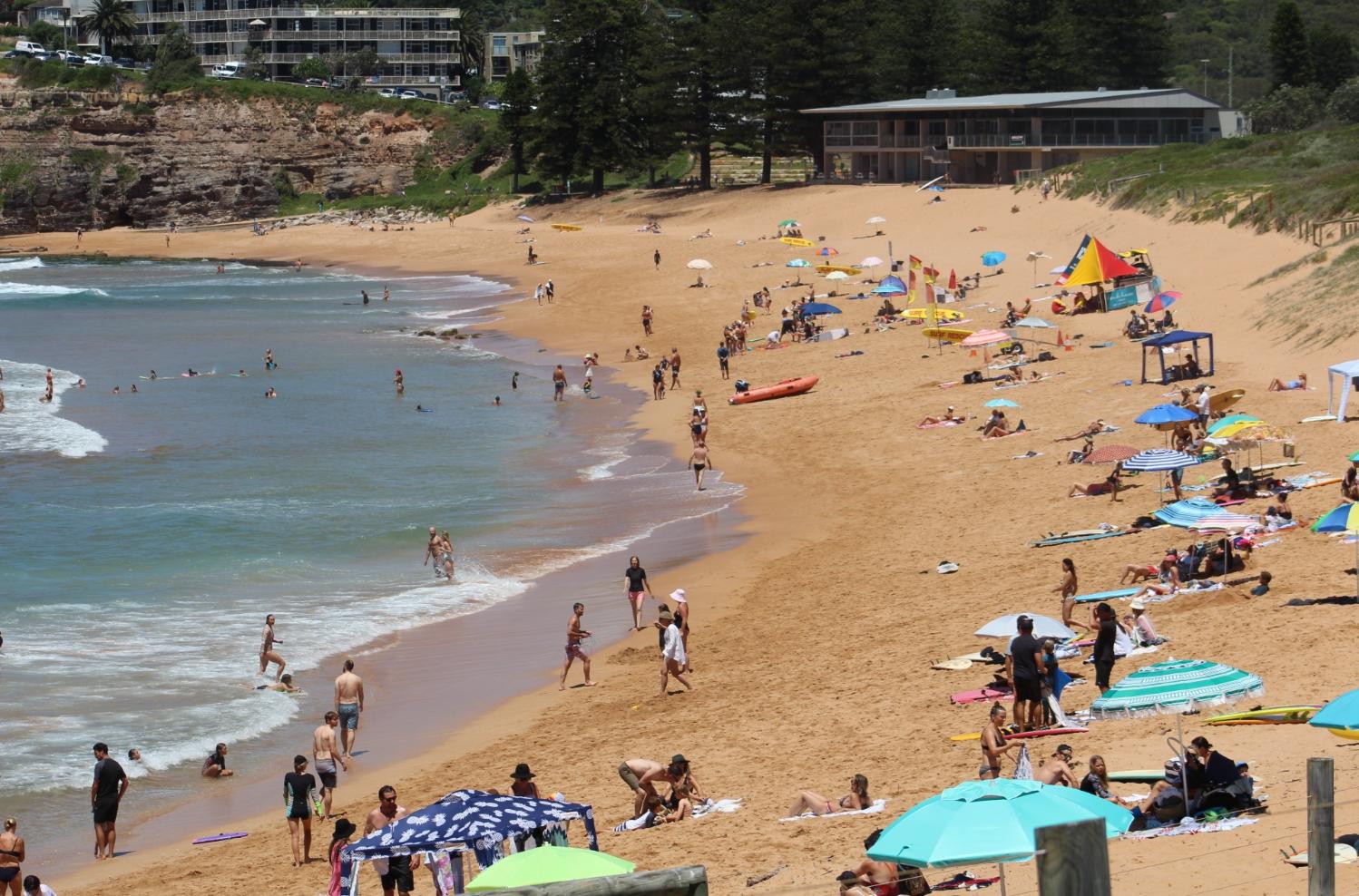
Would You Like To Improve Your Health & Wellbeing?
New Seniors Strategy Enables NSW To Age Well
Wendy Sharpe: Ghosts
Mosman Art Gallery until March 7, 2021
1 Art Gallery Way, Mosman
Support For Senior Australians During The Holiday Season
- HeadtoHealth – www.headtohealth.gov.au
- BeyondBlue (1800 512 348) – www.coronavirus.beyondblue.org.au
- Lifeline (13 11 14) – www.lifeline.org.au
- On the Line for the Suicide Call Back Service (1300 659 467)
- Older Persons Advocacy Network (OPAN) – www.opan.com.au
- Phoenix Australia – www.phoenixaustralia.org/aged-care
AvPals 2021
Free Diary Informs Seniors Of Their Rights
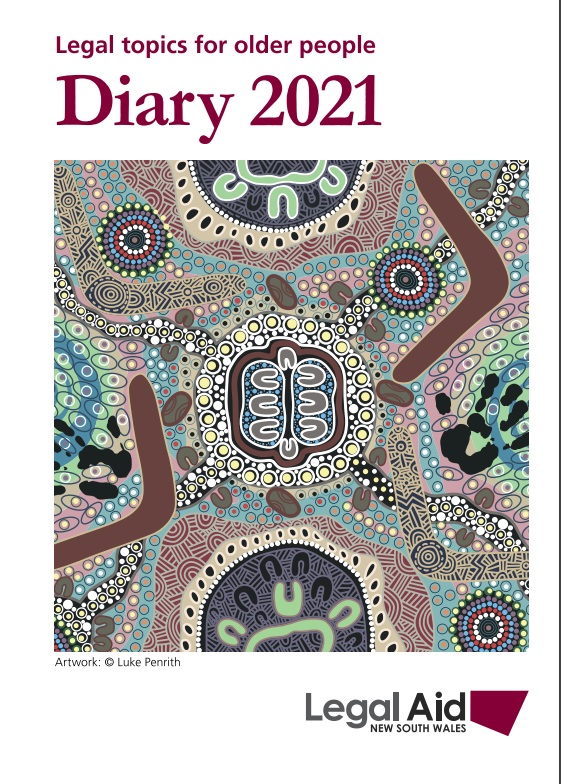
$44 Million To Extend Dementia Training, Education And Support
- Dementia Training Program (DTP)
- Dementia Behaviour Management Advisory Service (DBMAS)
- Severe Behaviour Response Teams (SBRT)
- Needs Based Assessment (NBA), which is a component of the Specialist Dementia Care Program.
A Prognostic Alzheimer's Disease Blood Test In The Symptom-Free Stage
Resistance Training Benefits Older Women Just As Much As Older Men
Contracts Signed For Rollout Of COVID-19 Vaccine
- Distribution and logistics— industry leading providers DHL Supply Chain and Linfox will undertake COVID-19 vaccine distribution.
- Data—Accenture will provide tracking of vaccine doses as well as enabling overall program implementation monitoring.
- In addition, PwC will be the Department of Health’s Program Delivery Partner for the vaccine rollout.
Preventing Nicotine Uptake By Young Australians With Prescription Based Vaping
- The previously proposed Customs (Prohibited Imports) Regulations will not be proceeding due to the significant overlap with the TGA decision.
- In consultation with the RACGP, AMA and other medical experts, the Government will develop a Telehealth Smoking Cessation item that will be available 6 months prior to the 1 October implementation date. As part of this work the Government will provide $1 million for an education campaign focussed on smoking cessation.
- The current available evidence does not support that e-cigarettes are a safer alternative to smoking cessation aids currently available.
- There is also currently insufficient evidence to conclude whether e-cigarettes can benefit smokers in quitting.
- Risk of nicotine addiction for new or continuing users.
- The introduction of novel nicotine delivery system may have a negative impact on tobacco control and may re-normalise smoking.
- Exposure to nicotine in adolescents may have long-term consequences for brain development, potentially leading to learning and anxiety disorders.
- Unknown toxicity of long-term exposure to heated and inhaled chemicals.
- Risk of accidental exposure to children, particularly in relation to liquid nicotine.
- Between 2015 and 2019, current e-cigarette usage by U.S. youth increased by approximately 1,128,000 young people aged 14-19 years (71.9% increase). This has resulted in a total of over 4 million U.S high students currently using e-cigarettes.
- In Australia between 2016 and 2019, the number of current e-cigarette users aged 15-24 increased by approximately 72,000 (95.7% increase) for a total of approximately 147,000.
- In addition, recent research from the Australian National University has found e-cigarette users are three times more likely to take up traditional cigarette products.
$45 Million Boost For Smart Places In NSW: EOI Sought
Multi-Million Dollar Tender Now Open For The Construction Of The World's Longest Wild Dog Fence
Sport Integrity Australia Advisory Council
- Ms Sarah Kenny (Chair)
- Ms Lynne Anderson (Member)
- Mr Peter Conran AM (Member)
- Ms Margot Foster AM (Member)
- Mr James Sutherland (Member)
- Mr Scott Draper (Member)
- Mr Ken Maroney AO APM (Member)
- Ms Megan Mitchell (Member)
- Mr Jason Marocchi (Member)
Reminder: Centrelink Debt Recovery Activity To Restart In February
First Tracks Laid On City & Southwest Metro
Disclaimer: These articles are not intended to provide medical advice, diagnosis or treatment. Views expressed here do not necessarily reflect those of Pittwater Online News or its staff.